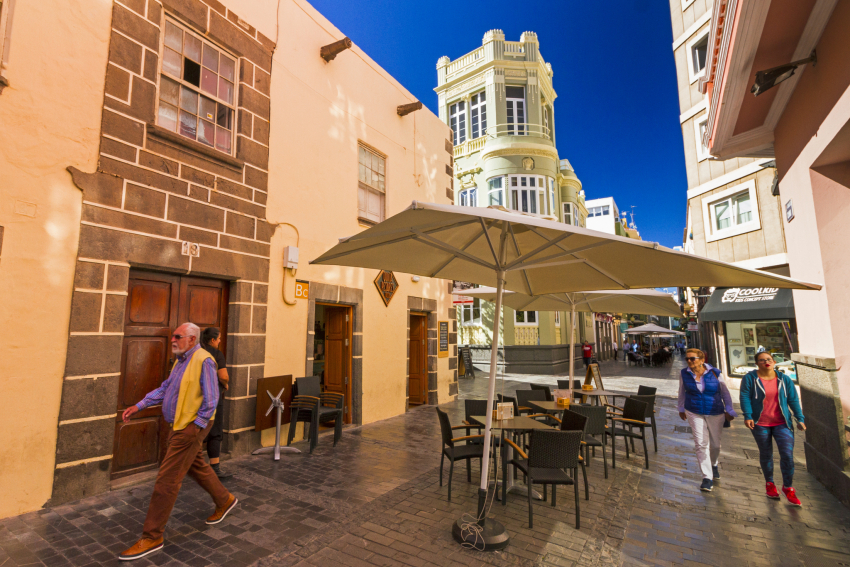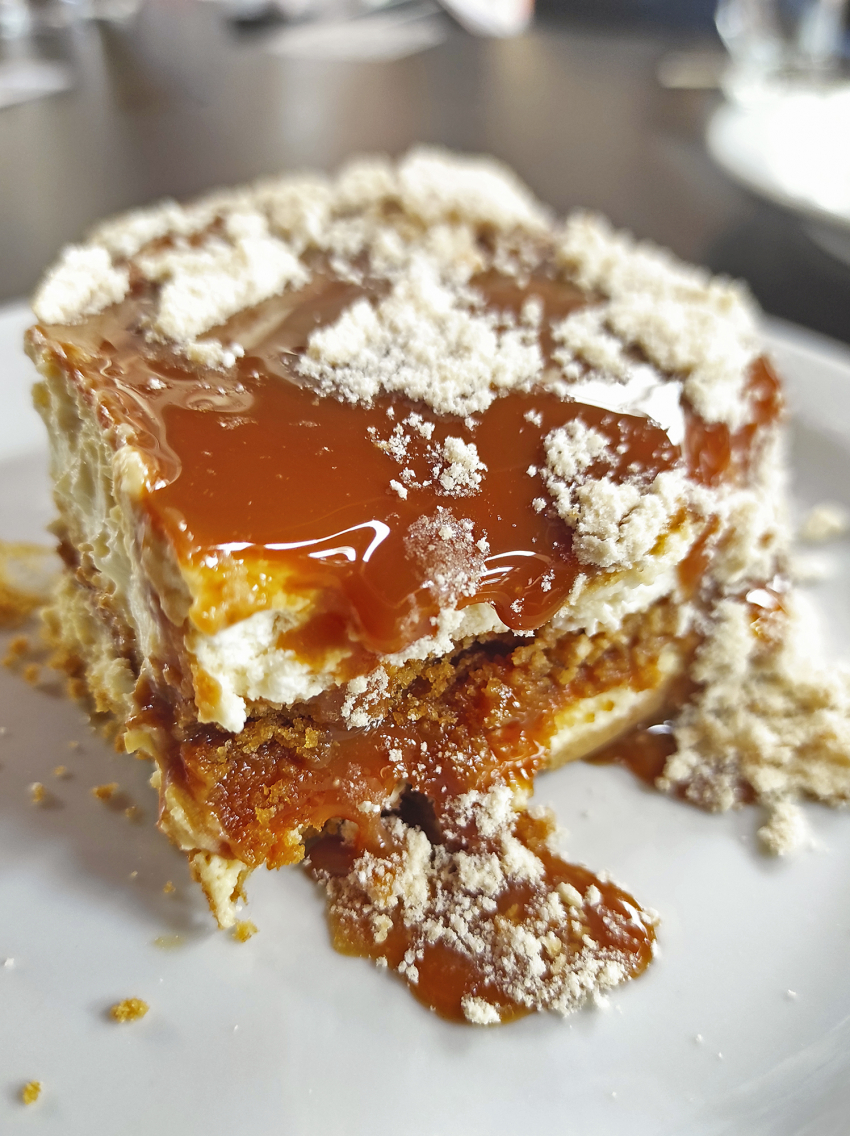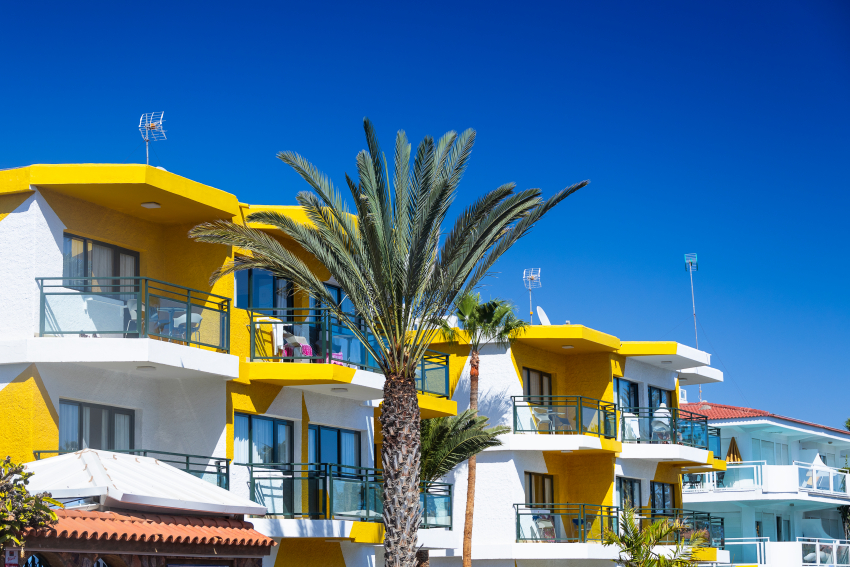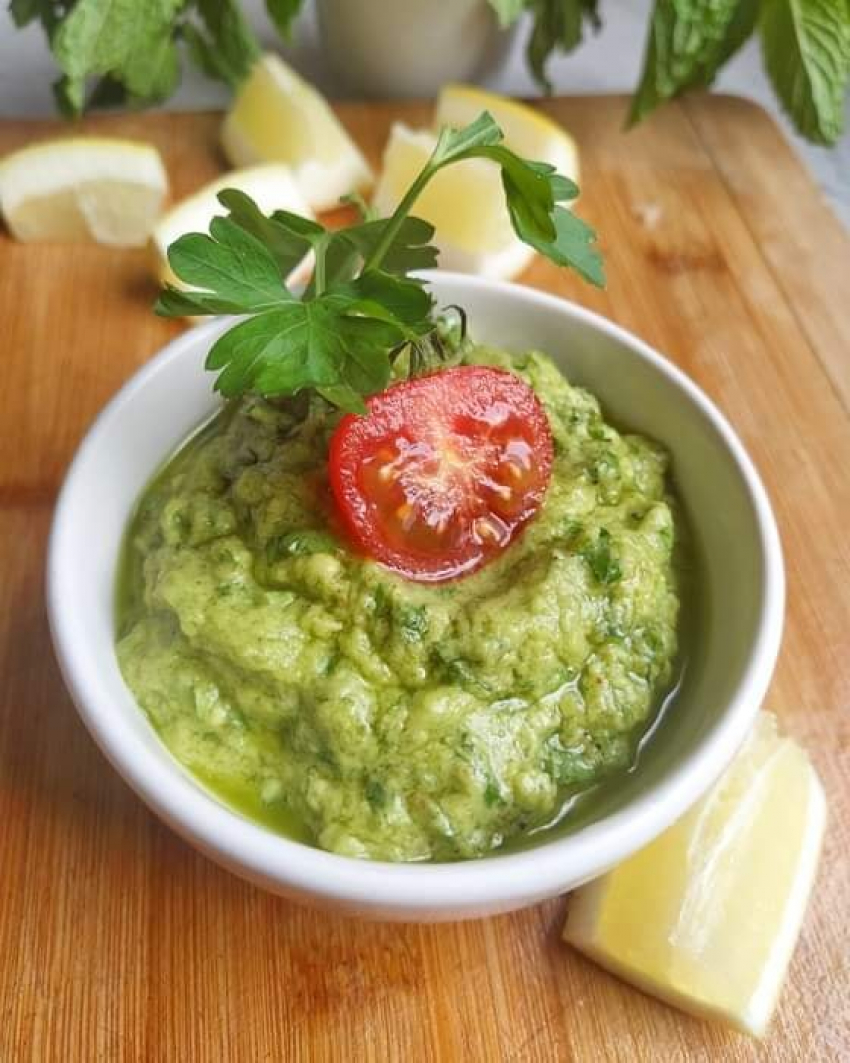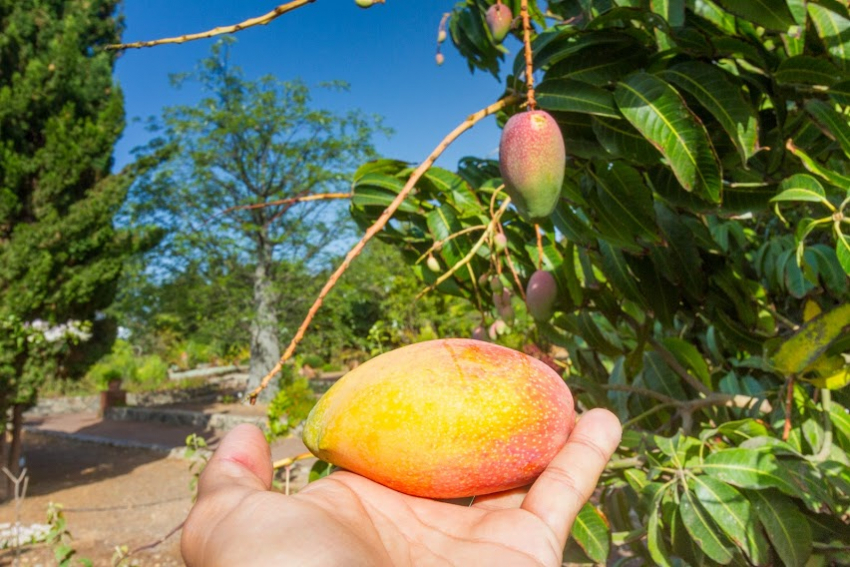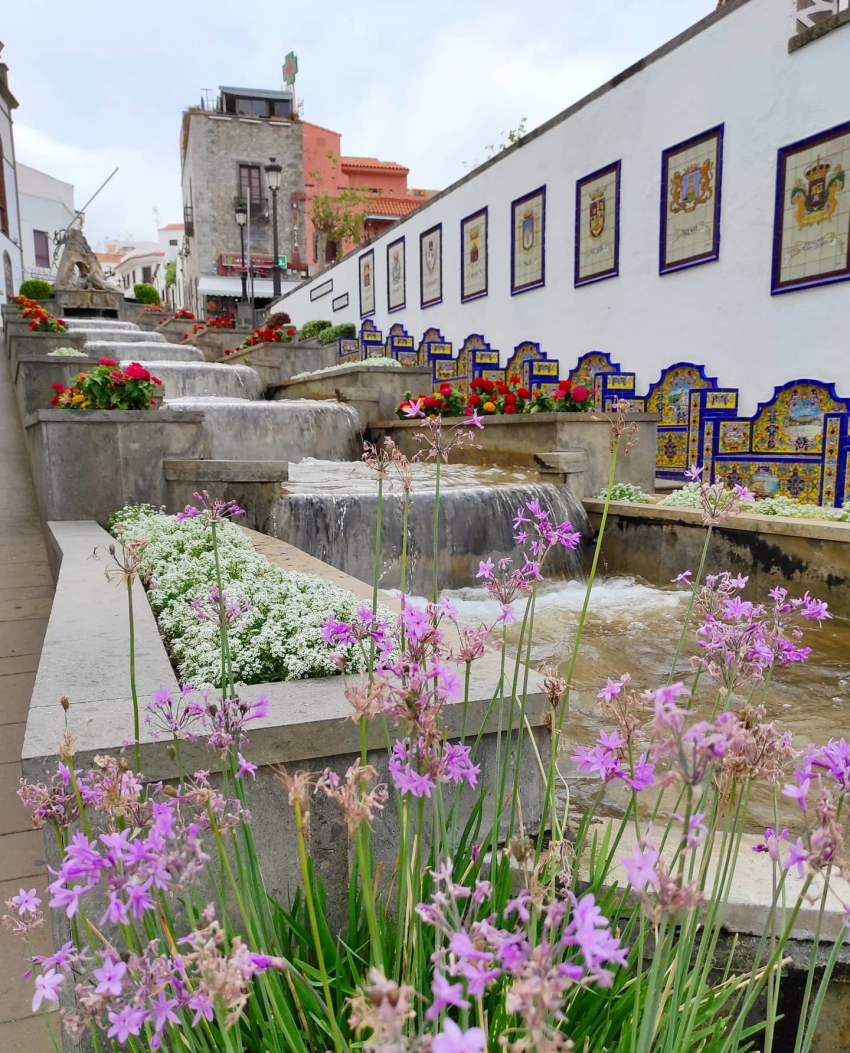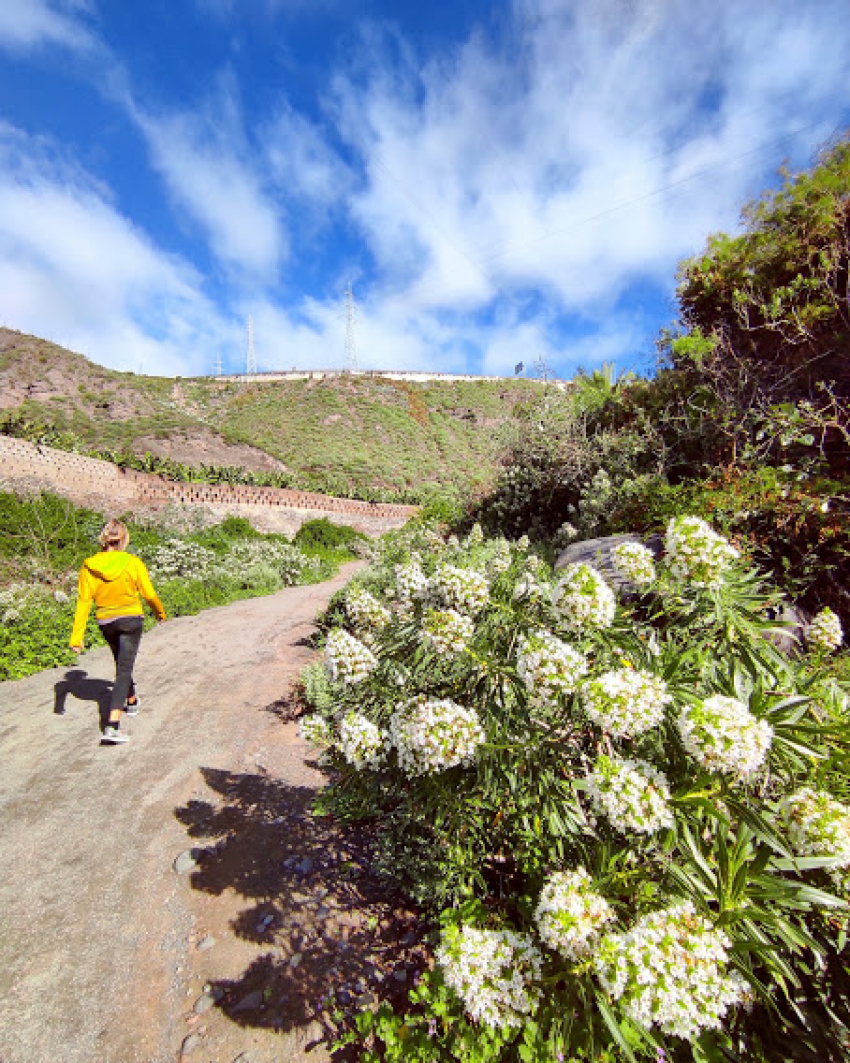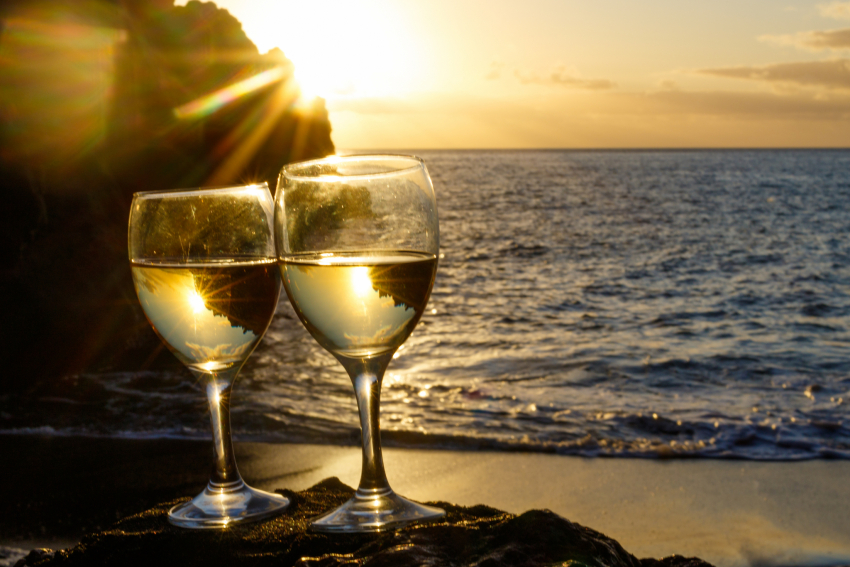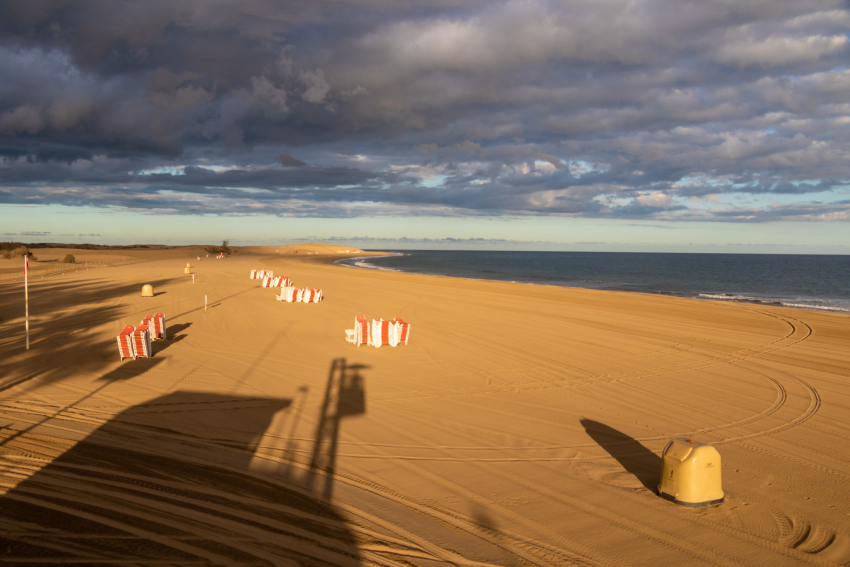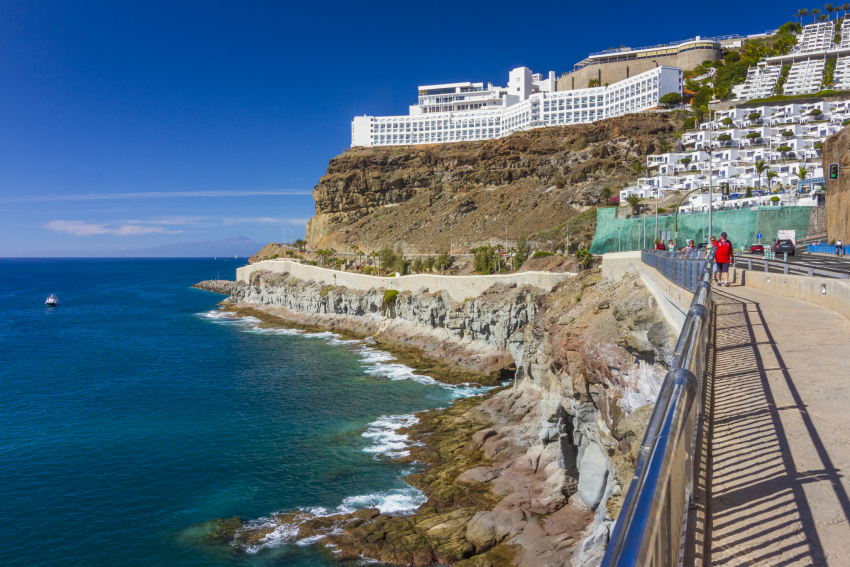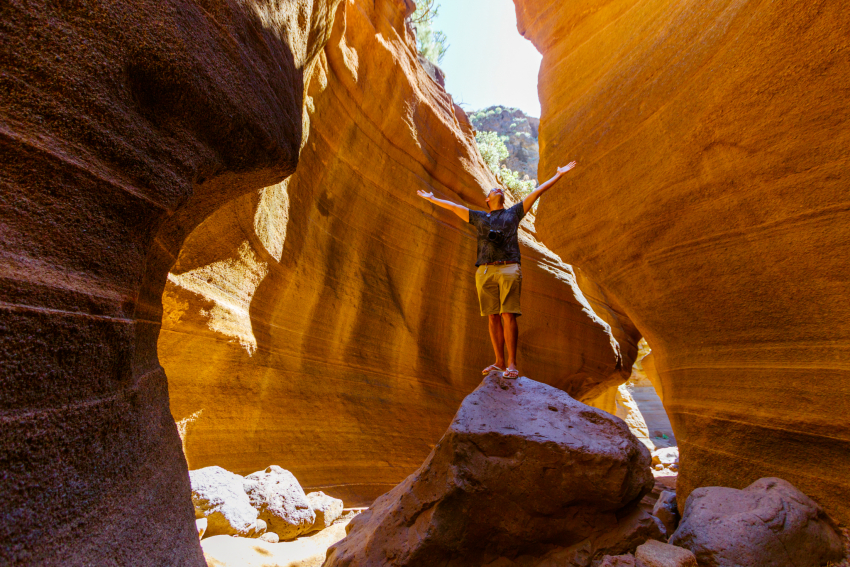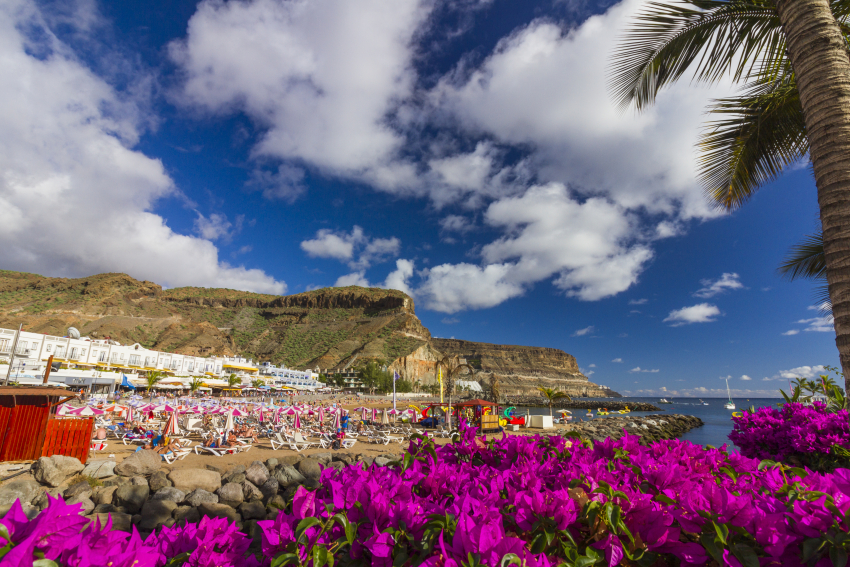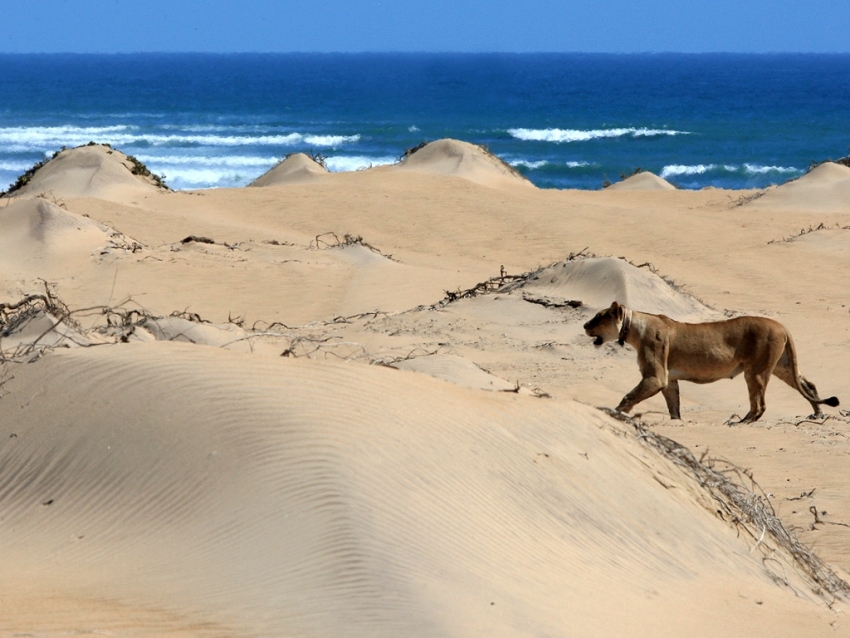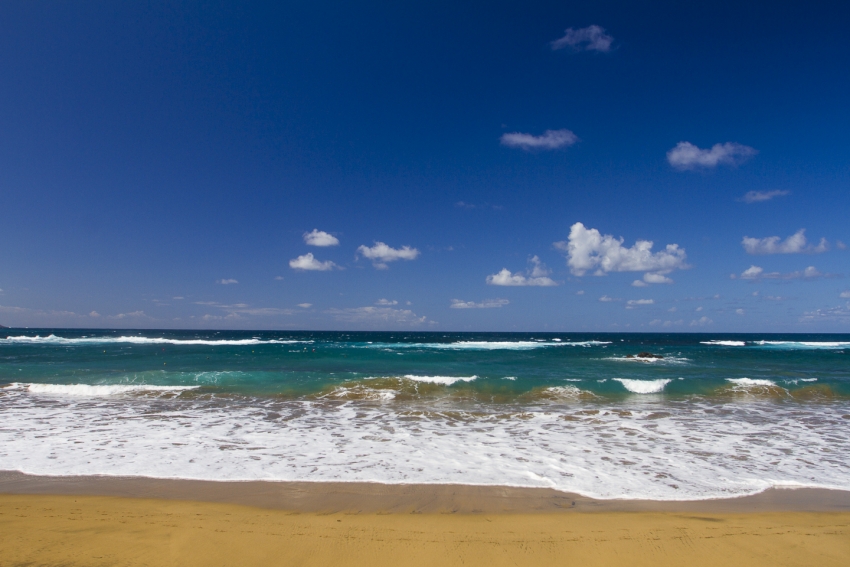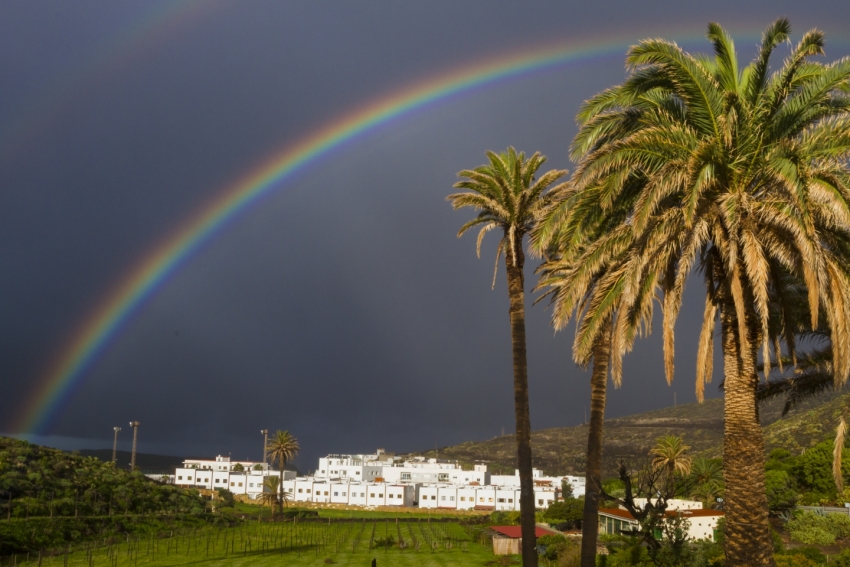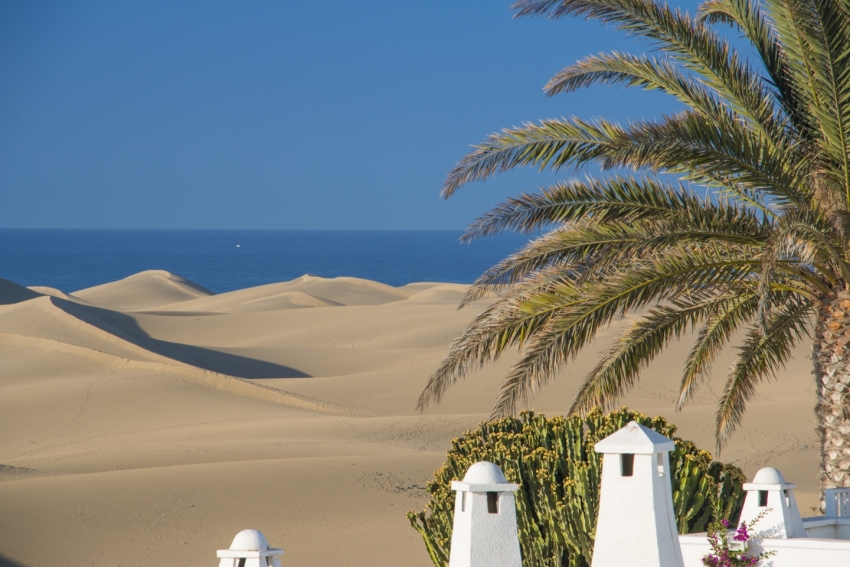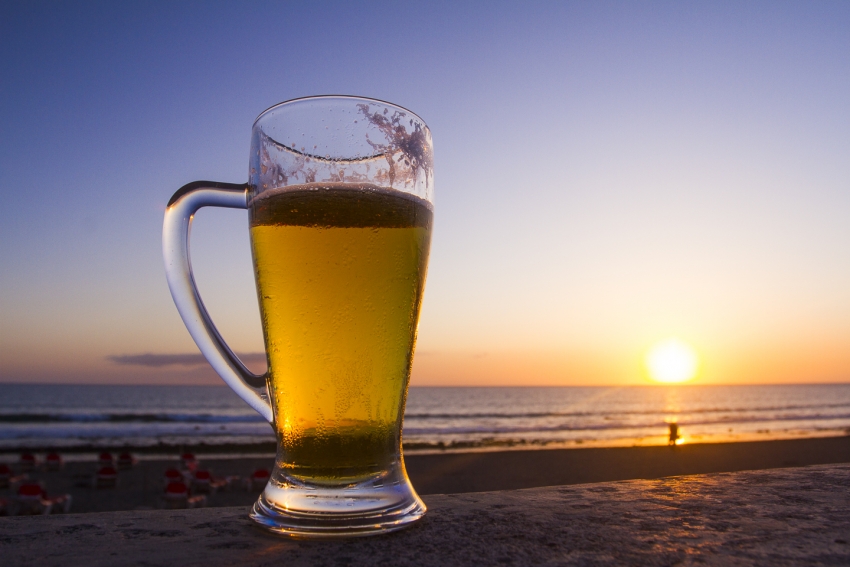Calle Cano: The Best of Old And New Las Palmas
When people come to Las Palmas, they either head to Las Canteras beach, or they wander the cobbles of Old Town Vegueta and Triana districts. Then they do some shopping, often along Calle mayor de Triana, recently voted the best outdoor shopping area in Spain.
However, most people miss the little streets that run off Triana’s high street and this is a real shame. While they lack the big names of the main shopping drag, they are full of small independent shops and charismatic local bars and restaurants.
It’s worth just wandering around these side streets and dipping in to the shops as they sell far more original goods than the big names on the main drag.
Calle Cano: Where old and new Las Palmas merge seamlessly
This pedestrian street is my favourite in the whole historical area of Las Palmas because of how old and new blend together.
If you start at the south end of Calle Cano, the architecture is medieval with squat old buildings with stone doorways and heavy-set doors. Note the traditional wooden balconies on the top floors.
There’s a restaurant right on the corner setting the tone with excellent Spanish ham and traditional food served at outdoor tables.
Casa Museo Perez Galdós: A museum dedicated to a Spanish wordsmith
As you walk north along the street you come to the Casa Museo Perez Galdós set in the splendid old building where Benito Perez Galdós, one of Spain’s most famous novelists and Spain’s leading 19th Century literary figure, was born in 1843.
You don’t have to read his detailed accounts of middle-class Spanish life to appreciate the museum. It’s a beautiful house with internal courtyards, high, wooden ceilings and lots of fascinating information about the author and the period he described so well with his pen.
Art deco and local flourishes along Calle Cano
Further north along Calle Cano and the medieval gives way to the early twentieth century with art deco wrought iron balconies replacing the more traditional wood. The shops here are local in character with hairdressers and even a nursery mixed in amongst the boutiques.
You’re never more than a few metres from a restaurant with outdoor tables shaded by big parasols. One popular place is Mr Kale, a thoroughly modern spot that caters to vegetarians and vegans. It serves healthy smoothies and snacks nd is opposite a boutique selling shoes that cost more than most people’s entire holiday.
The Librería del Cabildo: The best Canary Islands book shop
Or, stay on Calle Cano for the Libreria del Cabildo, a spectacular bookshop with the best collection of Canary Islands books I’ve ever seen in one place. Drop in between 09.00 ands 13.00, or 16.30 to 20.00 on weekdays, and have a browse as you’re sure to find something to read on the beach.
More restaurants, local Spanish food
Calle Cano ends at the Plaza de San Bernardo in a flourish of restaurants serving modern Spanish and traditional Canarian food.
The other side it turns into Calle Viera y Clavijo and the facades slowly become more recent until you reach the beginning of modern Las Palmas. There’s a lovely sushi hole-in-the-wall, a Bang and Olufsen store, and plenty of clothes and shoe shops to keep you occupied.
Viera y Clavijo is lined with Jacaranda trees so if you in Las Palmas in early summer the street is carpeted in electric mauve flowers.
At any point you can drop down one of the cobbled side streets and come out on the much busier and commercial Calle Mayor de Triana for a hit of contemporary high street fashion. Or, head a block up the hill to Calle Benito Perez Galdos for what is Las Palmas’ most hipsterish street with its home decoration boutiques, tattoo parlours, and a cluster of vegan and upmarket restaurants.
Keep walking south along Benito Perez Galdós and Calle General Bravo and you get back to the pretty Plaza del Cairasco with its tall palm trees and outdoor cafes. From here you are just a couple of minutes walk away from the Cathedral and the museums and galleries of Old Town Vegueta.
Article published originally on the excellent Hello Canary Islands website.
The Best Polvito Uruguayo In Gran Canaria
Gran Canaria's unique dessert, the Polvito Uruguayo, is on most dessert menus in Las Palmas and is now even served in some resort restaurants.
The history of the polvito uruguayo
Despite the name, it was invented in Las Palmas at the El Novillo Precoz restaurant by the Uruguayan owners. The restaurant is still there and still one of the best meat restaurants in Gran Canaria. If you stay in Las Palmas you really should go there and let the experienced waiters tell you what meat is best for you (they always know).
The polvito at El Novillo is a very light pudding made from layers of whipped cream, dulce de leche, biscuit crumbs, ground almond and crushed meringue. It is deliberately light because who wants a big stodgy pudding after eating a good steak?
From its origins on Calle Olof Palme the polvito has now become the one of the Gran Canaria dessert trinity along with flan de la casa and mousse de gofio.
The best polvito in Gran Canaria (so far)
To find the best polvito, head from one Las Palmas classic to another; the Bodega Extremeña right by the beach on Calle Franchy Roca. This small and resolutely traditional restaurant serves up some of the best Spanish food in Las Palmas from quality ham and cheese to tasty tortillas.
Try the range of slow-cooked meats served with mashed potato so tasty that you can eat all on its own that is the highlight of the menu. And of course, the polvito!
At Bodega Extremeña it is deeper and more substantial than the original and skips the almonds. However, it is still light enough to eat after a heavy dose of meat and mash.
If you try it and know of a better one, please let us know where to go...
The Best Gran Canaria Weather Forecast
The single most common question we get in the Gran Canaria Info group is...
What is the weather going to be like during my holiday?
The answer is almost always the same: If you are going to south Gran Canaria's resorts, it is very likely to be sunny every day. Yes, even in the winter. Yes, even though your weather app says it is going to be cloudy. Yes, even in January. And in February, etc.
Obviously it does sometimes rain in Gran Canaria, even in the sun-baked south, and there are occassional cloudy days.
To check for these rare rain and clouds there is no point using generic weather apps because they use data that averages out the weather and temperature across Gran Canaria.
This means that the forecast for Puerto Rico and other resorts includes weather and temperatrure predictions for inland and highland areas that are cooler and cloudier.
So, instead of believing your current weather app use the Spanish weather service website called the AEMET. It's website has detailed and very accurate forecasts for individual resorts, town and even beaches.
Here's the forecast for the Mogán area including Puerto Rico.
The mobile website works very well in English although the app is only in Spanish at the moment.
The Many Mojos And How to Majar Them
Red mojo or green mojo?
This is always the most answered question on our Facebook page and the red version is slightly more popular. This is probably because it comes on the papas arrugadas (wrinkly popes as they are sometimes translated on local menus). Somehow, red and green are the only two mojo variations that make it onto restaurant tables. But there is far more to mojo than a binary choice.
From red and green to almond and avocado
Almond mojo is made from garlic, pimentón and peeled almonds pounded with olive oil in a pestle ands mortar. In La Palma they add smoked cheese to green mojo, in El Hierro fresh cheese to red mojo. In La Gomera they add hard cheese to the mojo and and call it almogrote.
Then there's the superb but rarely made mojo de aguacate based on avocado, herbs, green chili and cumin. Even with the standard red and green versions, every family has their own mojo recipes.
Oregano in the green? Parsley! What about tomato in the red? Roasted tomato! Are you crazy? That is not traditional! It is in my village!
The only thing people can agree on is that the best version is made by their gran.
The truth is that mojo isn't about the exact amount of chili, spice or vinegar in the mix. It's about the effort you put into mixing it.
Throw all the ingredients into a blender and after a good blitz you get a passable mojo. But for a great sauce use a big, stone pestle-and-mortar and spend a good 15 minutes majando el mojo; grinding everything together as you gradually add the oil. The constant mixing emulsifies the oil and garlic and really gets the chili and spices infused. Mojo that is majado looks different too; thicker and textured rather than runny and homogenous. Like lava rather than ketchup.
To make an ever richer mojo, add avocado...
Avocados and the Canary Islands
Avocadoes are from Central and South America and arrived in the Canary Islands centuries ago. Canarians were eating them in salads long before the brunch revolution made them a supermarket staple. As a kid I had avocado and jamon Serrano bocadillos for school lunch.
So mojo de aguacate isn't just a reworking of guacamole to hitch Canarian food to the avo bandwagon. It's a bona fide Canary Islands recipe made by local grannies for generations.
It's also delicious!
Mojo de aguacate: The recipe
I'd like to say that this is my gran's mojo de aguacate recipe but she was from Liverpool. Nana made a mean apple pie but never really dabbled with garlic and only ate avocadoes halved with Worcestershire sauce in the hole.
So instead this is my mojo de aguacte recipe honed during the lockdown and tested on two fussy kids.
You need...
- A large avocado (a ripe Haas variety with the crinkled skin is best; check ripeness by wiggling the stump of the stalk. If it falls off easily, the avocado is ripe).
- A mixed bunch of coriander and parsley (one or the other is fine too)
- 1 large clove of raw garlic
- 100 ml olive oil (a light extra virgin oil is best)
- 25 ml of red wine vinegar
- Teaspoon of coarse salt (the coarser the better for the majada).
- Teaspoon cumin (lightly toasted to bring out the flavour)
- One spicy green chili like a Habañero or a Thai chili (to taste)
- Lemon juice
Remove the avocado flesh and chop roughly. Chop up the parsley and coriander. Grind the remaining ingredients in a pestle and mortar (blender on pulse mode if you must) as you add the oil. Add the avocado and herbs and mix into a rough paste. There's no need to grind the herbs but it helps to bash them a bit to get ther flavours out.
Add a squirt of lemon juice to stop the surface from browning (especially if storing for later).
Serve as a dip with veggies, or as a dressing for fish.
May the mojo be with you!
First Mango Spotted In Gran Canaria
The Gran Canaria mango season runs from summer through to February depending on the year. The first ones normally appear in the shops in July but this year they are really early.
This year Spar supermarkets are already selling little ones at an outrageous 10 euros per kilo. However, prices should fall fast as the main crop starts to ripen in the warmest spots in south Gran Canaria.
How to choose a good mango in Gran Canaria
Mangos grow all over Gran Canaria but the best ones come from the south and south west valleys like Arguineguín, Mogán and 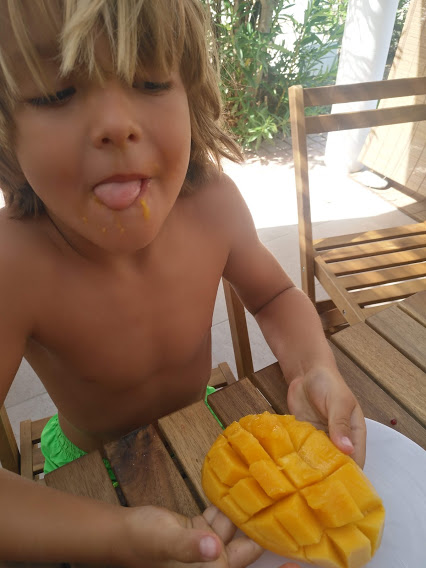 Veneguera. Really fresh ones have a faint white bloom on the skin, like a fine layer of chalk dust.
Veneguera. Really fresh ones have a faint white bloom on the skin, like a fine layer of chalk dust.
If you find a mango that smells great, it will taste just as good no matter what it looks like.The tiny yellow ones, often with sticky skin, are fibrous inside but taste delicious. Larger yellow or green ones have no fibres and you can smell them as soon as you walk into the shop.
Some varieties, like the big red ones, are delicious but don't have any odour at all. Choose one that is slightly soft to the touch but doesn't have black spots or by the stem (which indicate that it has started to rot before it ripens).
It's often best to buy local fruit in Gran Canaria from small shops and fruterias rather than the big supermarkets. The supply chain is shorter and the fruit less likely to be picked early and kept in cold storage.
Go Green In Firgas: Watercress And The Growing Call To Free The Water
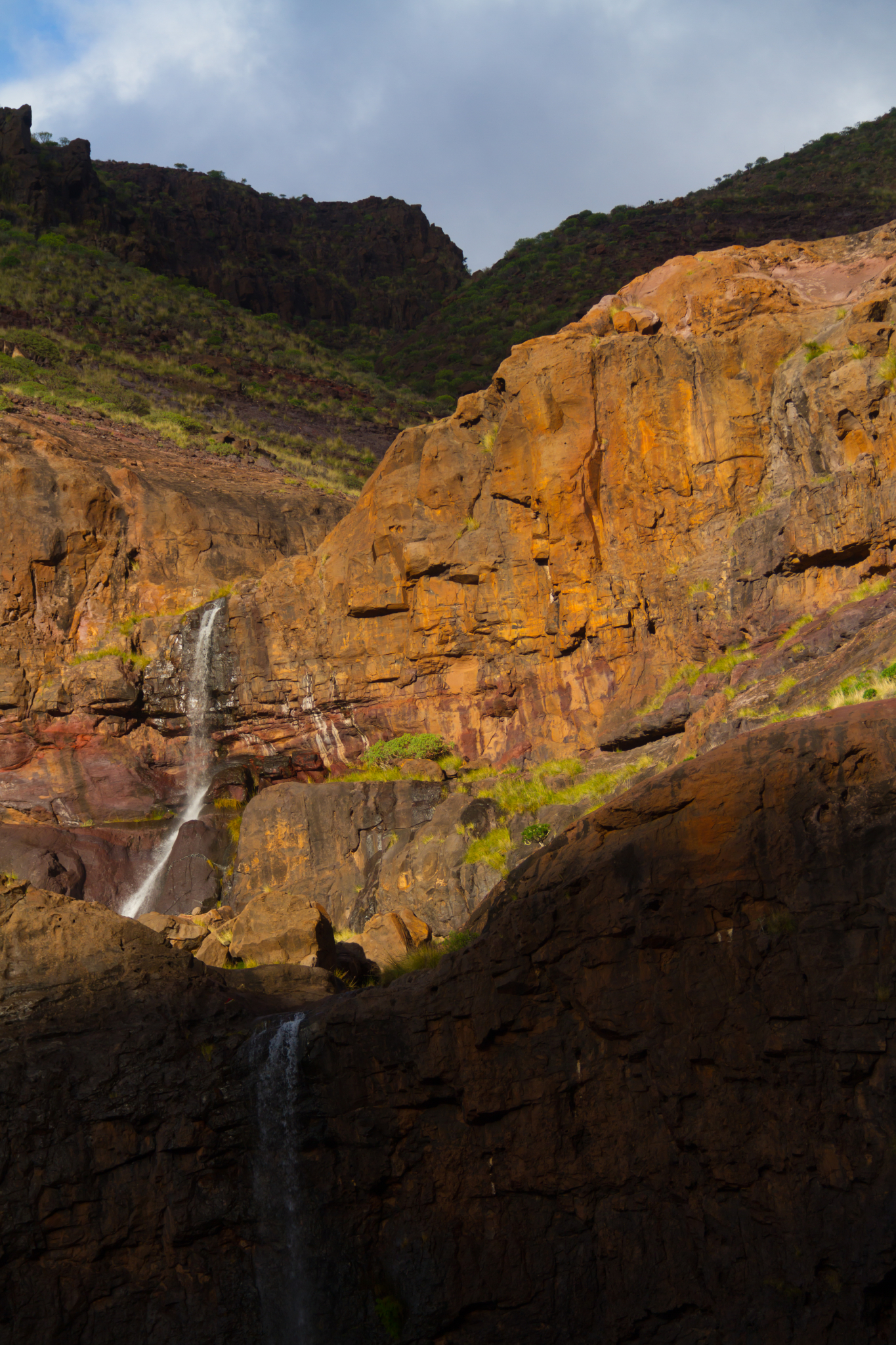 As you drive or walk around Gran Canaria you get the impresssion that it's a dry island because there is no water flowing in the valleys. However, this is an illusion as almost every barranco on the island should have a natural stream.
As you drive or walk around Gran Canaria you get the impresssion that it's a dry island because there is no water flowing in the valleys. However, this is an illusion as almost every barranco on the island should have a natural stream.
Before tourism, water was life in Gran Canaria. Vast networks of water channels carried it from natural springs and deep galleries carved into the island to where it was needed for drinking, washing clothes and watering crops. These stone waterways and aqueducts were built to last for centuries and managed communaly by the people they supplied. The washing points were meeting points for local commmunites and the flowing water kept valleys cool and allowed the island's birds to drink. The water was chanelled but still leaked out to keep palm groves watered.
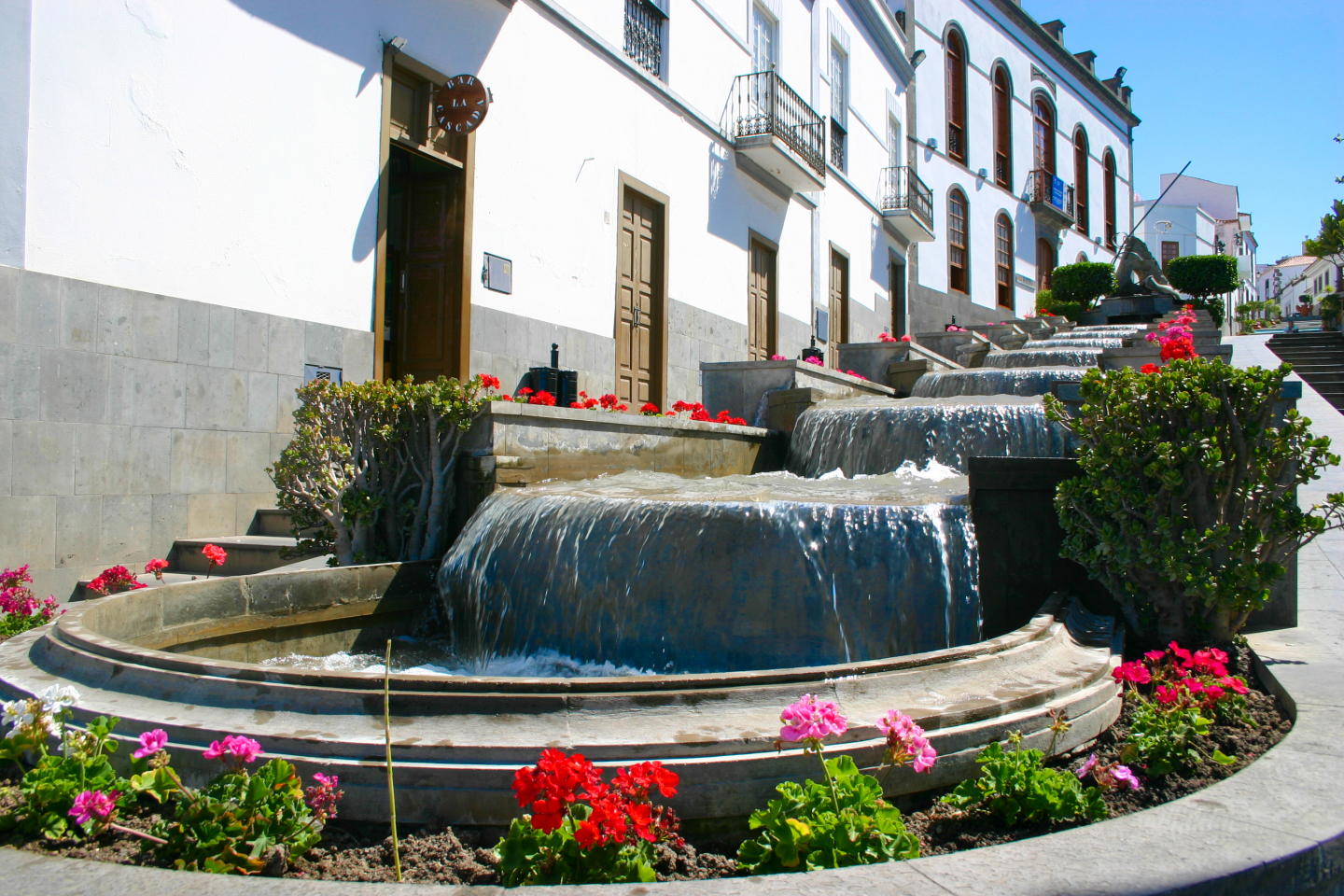 Nowadays most of the water runs through undergound pipes. The old water-sharing agreements have disappeared to be replaced with commercial contracts. Water no longer flows free and a shocking amount goes to irrigating unprofitable banana plantations that only make money thanks to huge subsidies.
Nowadays most of the water runs through undergound pipes. The old water-sharing agreements have disappeared to be replaced with commercial contracts. Water no longer flows free and a shocking amount goes to irrigating unprofitable banana plantations that only make money thanks to huge subsidies.
Palm trees all over the island, such as the Agaete Valley and Telde, have died in their hundreds and there are no streams to act as natural firebreaks during the summer.
Free the water: A common resource and vital for tourism
A growing number of local people are calling for change. Why does the island's water flow out of view? Why do a few people get to decide what it is used for? Why don't we put it back where it belongs; running free down the island's barrancos? Why do we spend a fortune keeping a few farmers in business when the money co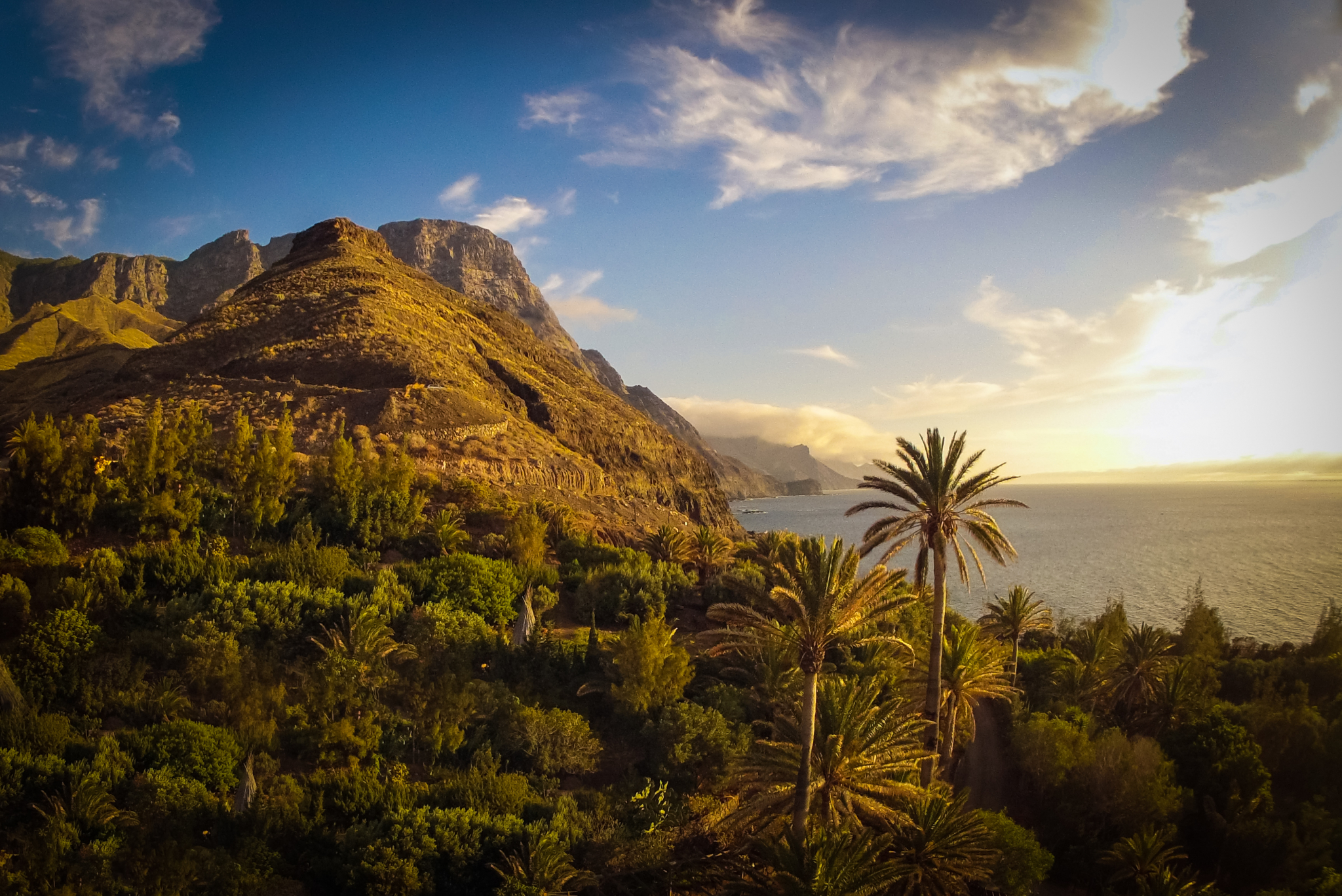 uld be spend on rewilding the island, replanting its forests and making Gran Canaria a more attractive place to live and to visit?
uld be spend on rewilding the island, replanting its forests and making Gran Canaria a more attractive place to live and to visit?
If Gran Canaria wants to be a more attractive place for walkers and visitors, putting the water back would be a good start. You only have to look at the popularity of the few places where free-flowing water remains; Azuaje, Barranco de los Cernicalos, Barranco de la Virgen up by Fontanales, and the water town of Firgas.
Firgas: Gran Canaria's water town
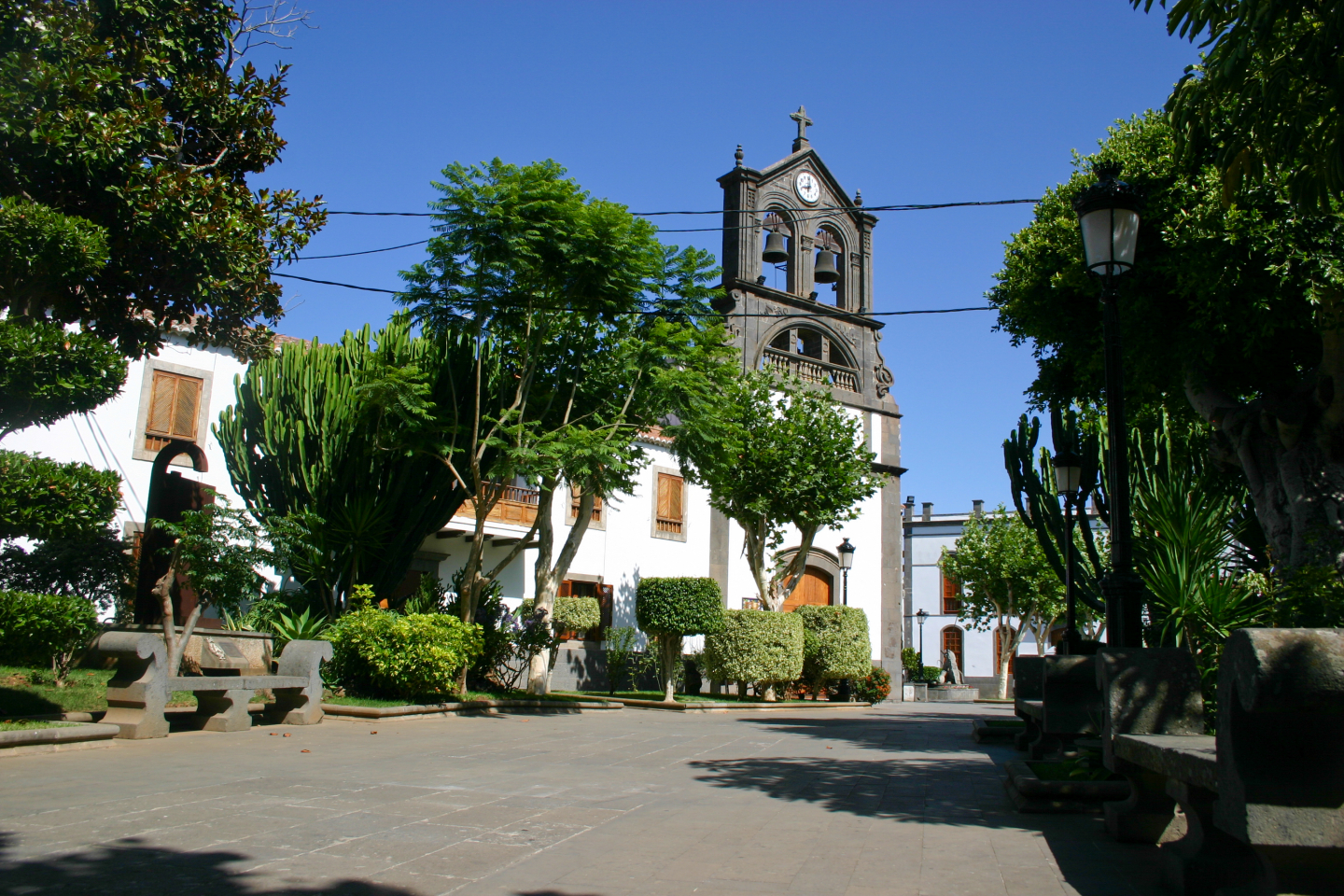 Firgas is the place in Gran Canaria that most visitors associate with water. The islands eponymous mineral water is bottled nearby and the main street in town has a flowing water feature. The old part of town is dotted with restored water mills, aqueducts and water channels.
Firgas is the place in Gran Canaria that most visitors associate with water. The islands eponymous mineral water is bottled nearby and the main street in town has a flowing water feature. The old part of town is dotted with restored water mills, aqueducts and water channels.
In the surrounding countryside, the main crop isn't bananas but watercress or berros, essential ingredient of one of Gran Canaria's most famous dishes; potaje de berros.
And where better to try it that in Firgas itself?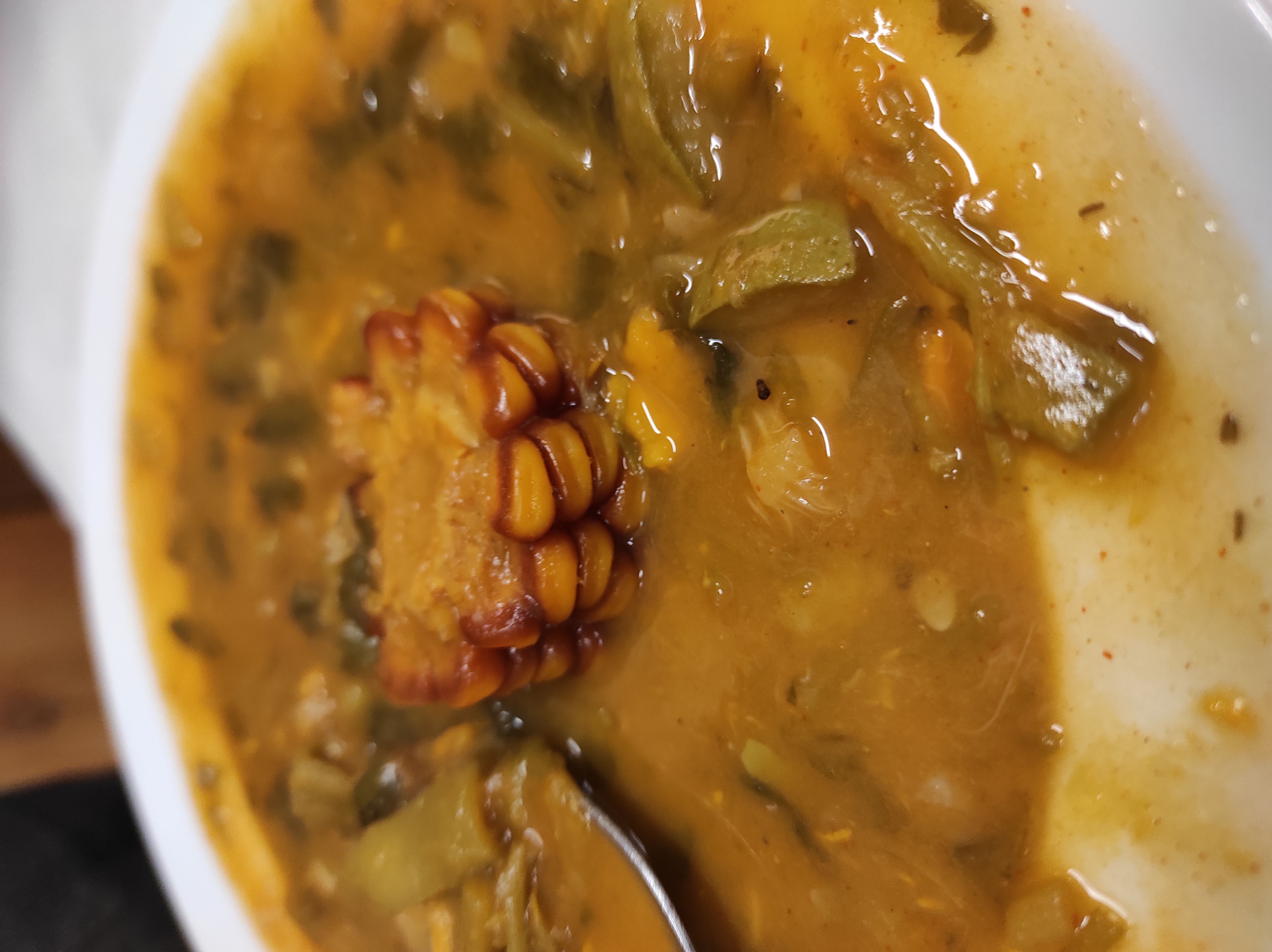
Any restaurant in or around town will serve you up a bowl of watercress, maize and pork soup, often sprinkled with gofio (toasted maize flour).
But one restaurant has upped its berros game beyond just potaje...
El Rincón de Marcos goes all in on the green stuff
El Rincón de Marcos, five minutes walk southwest of the Firgas church, puts watercress into everything. Green, pepperry bread, cress croquettes, green alioli, salads loaded with watercress, watercress soup, even a flan (creme caramel) with a greenish hue for dessert.
The potaje de berros, alioli and croquettas are excellent, as is the bread. The dessert and a couple of other green dishes are more about the novelty than anything else (does anyone re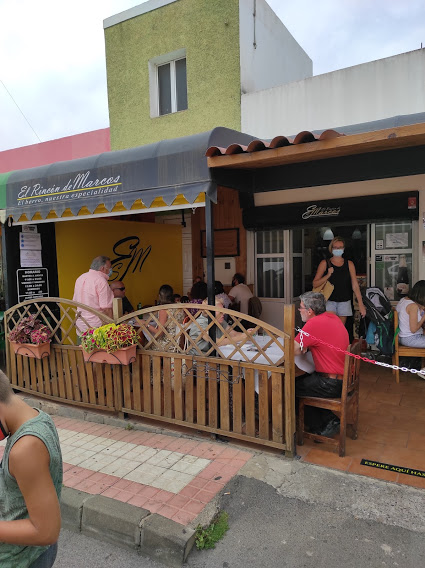 ally need a green flan?). It also serves plenty of non-watercress options like steak, calamares and papas arrugadas.
ally need a green flan?). It also serves plenty of non-watercress options like steak, calamares and papas arrugadas.
The restaurant itself is rustic with an outdoor terrace for warm days and cosy indoor rooms for the inevitable wet days. There's a reason why Firgas is famous for water; it's one of the island's rainiest spots.
Book el Rincón de Marcos if you plan to visit Firgas at the weekend but you should be fine just walking in on weekdays, especially if you turn up early (before 14.00).
1
Firgas town in north Gran Canaria is famous for water. The island's eponymous mineral water is bottled nearby, the main street has a waterfall, and the old part of town is dotted with restored mills and aqueducts.
White Flower Walk In Las Palmas' Only Wild Valley
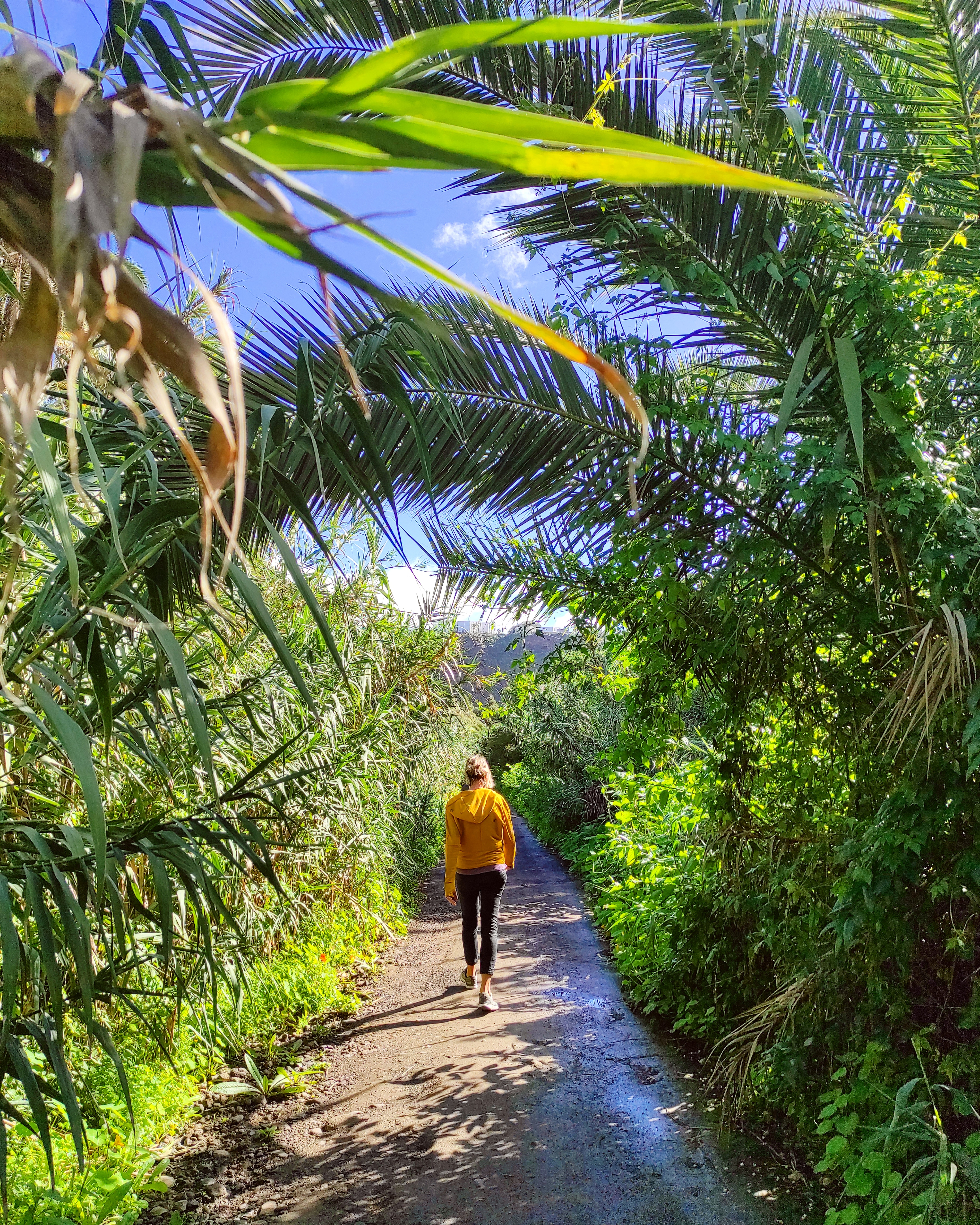 Late January and early February is the perfect time to explore Las Palmas' only remaining wild valley; The Guiniguada Barranco. It's when it's at it greenest and the white echium bushes are in full flower.
Late January and early February is the perfect time to explore Las Palmas' only remaining wild valley; The Guiniguada Barranco. It's when it's at it greenest and the white echium bushes are in full flower.
It's an easy walk between Triana and Santa Brigida past the Jardín Canario botanical garden. The path has recently been widened so you can now walk or mountain bike all the way to Santa Brigida town without having to scamble over the barranco floor.
From the start of the trail by Triana, it is 8.8km to the Maipez bar just below the Jardín Canario. From here you swap into the Barranco de Santa Brigida and a further three kilomtres takes you past La Calzada village to arched bridge popular with bungee jumpers. The trail continues for 5km up the wide valley floor all the way to Santa Brigida past Angostura and Las Meleguinas villages.
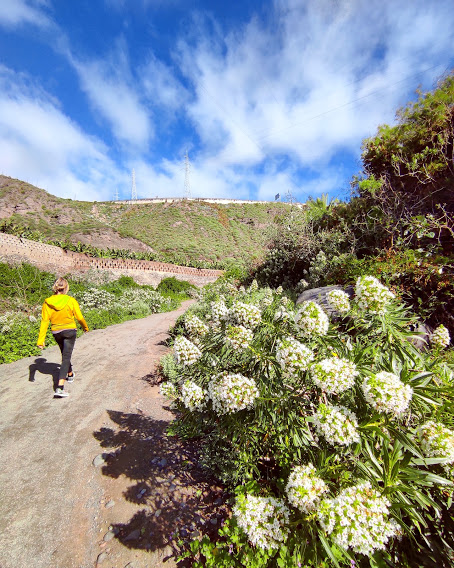 The lower part of the trail goes past banana plantations before the valley gets wilder and you leave the ridgetop houses of Las Palmas behind. The top half is greener and narrower with more banana plantations and some big houses. Between the Maipez and the Angostura bridge the barranco is narrow and steeper while the ñast part is a is a mix of fruit orchards, farms and palm groves.
The lower part of the trail goes past banana plantations before the valley gets wilder and you leave the ridgetop houses of Las Palmas behind. The top half is greener and narrower with more banana plantations and some big houses. Between the Maipez and the Angostura bridge the barranco is narrow and steeper while the ñast part is a is a mix of fruit orchards, farms and palm groves.
There are no shops or toilet facilities along the way so take plenty of water and snacks. The trail is wide and not steep although bits of it are cobbled and awkward on a bicycle. The top half of the walk has several picnic sites with shade and benches.
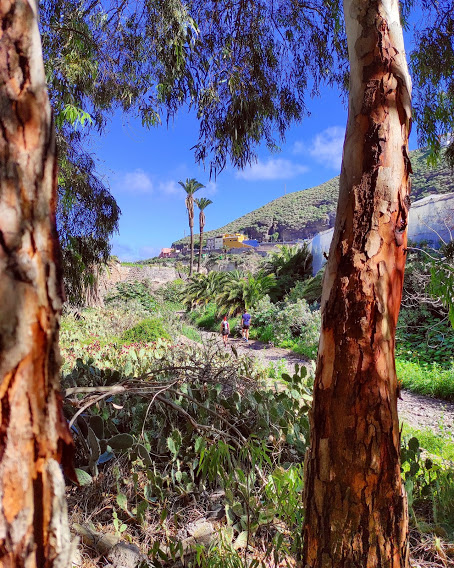 Normally, you can keep walking along the roadside to the bottom entrance of the Jardín Canario, then up through the garden to the bus stop for a ride back down to Las Palmas. However, the JC is only open via the top entrance at the moment betwenn 09.00 and 14.00.
Normally, you can keep walking along the roadside to the bottom entrance of the Jardín Canario, then up through the garden to the bus stop for a ride back down to Las Palmas. However, the JC is only open via the top entrance at the moment betwenn 09.00 and 14.00.
If you want to stop walking at the Maipez (9km from Triana) the best option is to call a taxi (less than 10 euros back to the city). The Maipez itself is still open although you aren't allowed inside at the moment. Its devilled eggs (huevos rellenos) are a good snack after a long walk.
The best radio taxi service in the area is TARA: 928 460 000
Nature Notes
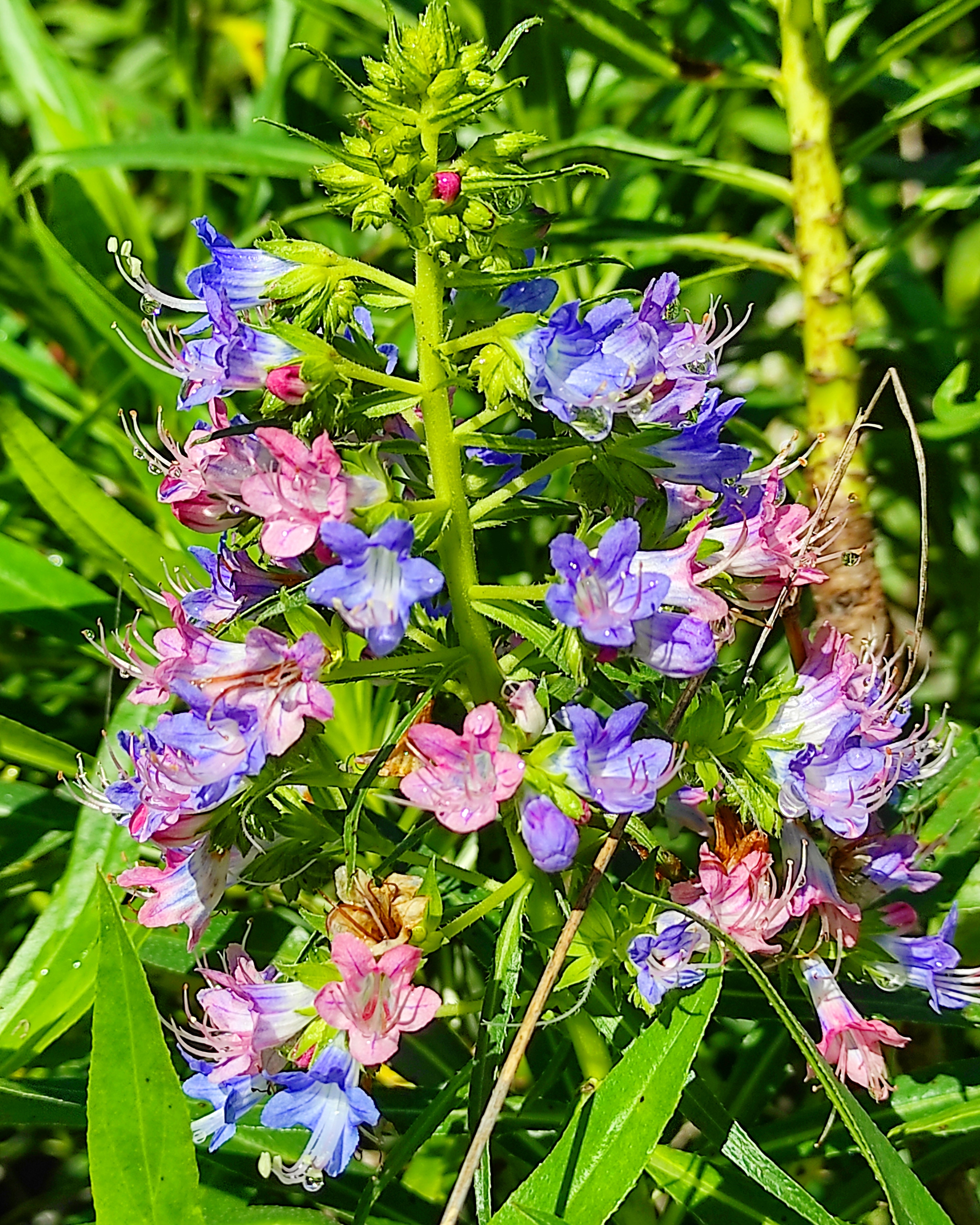 Every January the Guiniguada Valley explodes into colour as the white echiums flower alongside daisies and nasturtiums.
Every January the Guiniguada Valley explodes into colour as the white echiums flower alongside daisies and nasturtiums.
The echiums in the Guiniguada are Echium decasnei with white flowers but you do get the odd blue plant as well (see photo right). In the lower part of the Guayadeque Valley many of the E. decasnei have blue flowers.
The palm trees in the lower part of the valley are nesting sites for ring-necked parakeets and there are pairs of kestrels all along the trail; we saw two mobbing a buzzard. Gran Canaria blue tits, chiffchaffs and Berthelot's pipits (running along the ground) are common.
Tried and Tasted Guide to Canary Islands wine
Welcome to the Tried and Tasted Guide to Canary Islands wine
It’s a guide for the enthusiastic wine drinker who wants to know more about the unique grapes and wines of the Canary Islands.
Once you’ve read it, you’ll know enough about Canarian wine to recognise a good Malvasía and know why La Palma wines taste of pineapple and Tenerife wines of almond blossom.
TRIED AND TASTED: CANARY ISLANDS WINE
Millions of people a year drink Spanish wine in the Canary Islands without realising that they have a thriving wine industry.
It’s a huge shame because as soon as you start to explore Canarian wine, you find that it’s more than a tourist gimmick. With hundreds of wineries and dozens of local grape varieties, the Canarian wine scene has something for everyone and is a vital part of the rural economy.
What’s special about Canarian wine
John Keats: Lines on the Mermaid Tavern
Have ye tippled drink more fine
Than mine host's Canary wine?
Three things make Canarian vines and wines special...
Ancient grapes
The Canarian flora is a living fossil with over 600 species of plants that grow nowhere else on Earth. These remnants of an ancient Mediterranean vegetation that was squeezed into oblivion between the ice of Europe and the Sahara desert.
Canarian plants survived on the Atlantic Islands thanks to the temperate Atlantic Ocean.
Millions of years later, the grapevines of the Canary Islands pulled off a similar feat of survival.
In the 1860s, an American vine aphid known as phylloxera hitched a lift across the Atlantic on one of the first steamships and ravaged continental Europe’s vineyards. The bugs fed off the roots of European vines and spread a deadly fungus.
Growers tried everything from putting toads next to their vines to massive doses of chemicals, but nothing stopped their vines from withering.
Many ancient varieties died out completely and the survivors had to be grafted on phylloxera-resistant American rootstocks. Within a few short years, Europe’s vineyards,and the taste of the wines they produced, had changed beyond recognition.
The taste of ungrafted pre-phylloxera wine has gone forever, except for a tiny number of wildly-expensive bottles coming from few patches of pre-phylloxera vines that survived in volcanic soils across Europe. Even in these areas, the original vines were replaced with modern varieties.
However, in the Canary Islands, phylloxera never struck and the vines that grow today descend directly from the original plants brought from Europe.
Canarian vines are therefore the only vines on Earth that can trace their lineage back to the vines brought to Hispania by the Ancient Greeks and Romans.
Recent genetic studies have shown that several Canarian grape varieties, such as Tintilla, Marmajuelo and forastera blanca, have no known ancestors. It’s likely that their ancestors died out during the phylloxera plague of the 1870s leaving them as the last of their kind.
Like the laurel forests, viper’s bugloss flowers and houseleeks, Canary Islands grape vines are living fossils.
But they taste much better.
500 years of adaptation
Vines came to the Canary Islands from Spain, and from Madeira island to the north, as early as the 1450s. Since then, they have slowly been adapting to local conditions. Growers use cuttings from the vines that are best adapted to the local weather and soil to populate new vineyards.
The result, after 570 years, is vines that thrive in the local climate and soils and produce wines as spectacular as the islands they are from.
The Canarian climate and terroir
The Canary Islands climate is one of the best in the world, at least for people.
From grapevines, it’s more of a challenge; the African sun and young volcanic soils packed with minerals mean that grape vines are at the edge of their comfort zone.
The results is grapes packed with sugar, minerals and character and wines with intense aromas and flavour; Great for the whites, but more of a challenge for the reds.
A brief history of Canarian wine
William Shakespeare: King Henry IV
You have drunk too much Canaries, and that´s a marvellous searching wine
Canarian wine was once a global superstar exported to three continents.
However, the Canary Sack of Shakespeare fame was fit for drowning a Duke but not for modern supermarket shelves. It was a strong, sweet drink and a long way from the dry, fruity wines popular today.
Origins
The Canarian wine industry started in the 1450s as soon as the Spanish took control of the islands from the original inhabitants. However, the first European vines were imported as early as the 1350s when the first missionaries arrived on the islands.
However, the recent discovery of grape seeds in a pre-Hispanic settlement in Tenerife is a tantalizing hint that the island’s aborigines brought vines with them centuries earlier.
Boom & bust
Wine wasn’t a big export until the sugar cane export industry collapsed.
Faced with cheap sugar from Caribbean and South American plantations, Canarian farmers turned their hand to making wine.
By the mid-16th Century the islands, and especially Tenerife, were exporting sweet Malvasía wine to the New World, Britain and Europe. By the 17th Century the islands exported most of their wine to Britain.
The rot started in 1666 when a British company tried to monopolise the trade and got chucked out of Tenerife. Britain responded by banning imports of Canary wine.
The next year, Charles II’s Portuguese wife persuaded him to favour Portuguese wine and the 1701 War of the Spanish Succession forced British wine merchants out of Tenerife for good.
The Canarian wine trade with Britain faded as it turned to Portugal and Madeira for its booze; wine-making in the Canaries spent the next 150 years as a domestic industry.
By the start of the 19th Century, Canarian and especially Tenerife wine was back in-demand in Britain and the Americas. By 1863 the islands were producing 40,000 pipes (about 500 litres per pipe). However, attacks of powdery mildew disease in 1852 and 1878 set everything back again.
Another recovery followed, but was stymied by the First World War. Canarian wine faded completely from the scene.
Until now.
Canarian vines in the Americas
The first vines planted in the Americas, known as Mission grapes, are descended from the Listán Negro or listán prieto variety growing in the Canary Islands in the early 16th Century.
Spanish colonists took vines from the Canaries rather than transport them all the way from Spain. Missionaries then spread them throughout the Americas, up into the United States and down into South America (where it is known as criolla).
Worth paying: The price of Canarian wines
William Shakespeare: Twelfth Night
O knight thou lackest a cup of canary; when did I see thee so put down
A common complaint amongst casual wine drinkers in the Canary Islands is that Canarian wines are more expensive than imported Spanish wines.
This is unfair as you simply can’t compare the two.
The rugged geography of the Canary Islands means that local vineyards are tiny and all the vine maintenance and grape picking has to be done by hand. Consequently, there is no way the Canarian wine industry can compete on price with vast, mechanised Spanish vineyards.
And it shouldn’t have to.
Instead of comparing Canarian wine to cheap, branded Riojas from vast estates, compare it to single-estate wines made from hand-picked grapes.
Good luck buying one from anywhere for less than 15 euro a bottle.
Quality Canarian wines, on the other hand, start at 6-8 euros per bottle in the shops.
Given the work involved in harvesting and making the wine, their pre-phylloxera history, and the vast range of unique local grape varieties and microclimates, Canarian wines are superb value.
Supporting local and rural life
Another huge benefit of drinking Canarian wines is that you support local farmers and wineries that keep the Canarian countryside looking spectacular.
Without wine, large areas of Lanzarote would be abandoned and centuries of tradition lost. The same goes for rural La Palma, the Gran Canaria highlands and huge areas of Tenerife countryside.
Think of drinking Canarian wine as a pleasant way of supporting local life and of offsetting those carbon emissions from the flight to the islands.
Then open another bottle.
Canarian wine varieties
Robert Louis Stevenson: The Black Arrow
A little good canary will comfort me the heart of it
Identifying Canarian grape varieties is a headache. Each has several names depending on the island, area and even estate where it grows. Recent genetic studies are unravelling the mess but often add as many mysteries as they solve.
For example, a recent study found that there are over 20 different varieties of Malvasía vine growing in the Canary Islands. One grows in a single vineyard in Lanzarote.
The situation is further complicated by wineries focusing on the unique nature of their grapes in order to appeal to patriotic local buyers,and by the fact that Canarian microclimates mean that identical vines produce very different wine even in adjacent wine areas.
Is Lanzarote’s diego grape the same as Gran Canarian Vijariego blanco, or El Hierro verijadiego, or Tenerife’s bujariego? Is Listán Negro different from Listán Prieto?
Nobody knows, but everybody has a strong opinion, especially after a few glasses of vino. The truth is that it hardly matters. The quality of the wine is more important than the grape it came from.
And the terroir of the Canary Islands is so varied that the same grape does very different things depending on where it’s grown.
Canarian white grape varieties
The different Canarian DOs allow over 20 white wine grape varieties but these are the most common and interesting local ones.
Malvasía
The star of Lanzarote, but also planted widely in southern La Palma and Tenerife and grown on all the islands. Malvasía is originally Greek and comes in white, pink and red forms, although almost all Canarian Malvasía is white.
You sometimes see Lanzarote Malvasía referred to as ‘Malvasía Volcánica’. The theory is that it has changed so much to adapt to local growing conditions that it is now a separate variety.
Not to be outdone, Tenerife and La Palma growers call their Malvasía ‘Aromática’.
Tasting Notes
Malvasía wines have a floral or fruity bouquet with hints of white fruit, orange blossom and honeysuckle.
In the mouth they present strong notes of peaches and apricots (some say white currants, but we’ve never even seen one) along with citrus and blossom. They feel quite full or fat in the mouth.
Good Malvasía wines have a zing to them; like there’s a tiny bit of sherbert in each sip that lifts all the flavours.
Albillo / Gual
Local wine buffs argue for hours about whether Gual is the Canarian name for the Spanish Albillo grape or whether it is a variety in its own right. Both names are used on bottles and the flavours are similar.
Albillo/Gual is common in Tenerife but also grown on El Hierro and northern La Palma, where it is called Albillo Criollo and produces fabulous whites. The Gual name is used in Tenerife.
Wines made from Albillo and Gual last well in the bottle.
Tasting Notes
Albillo produces golden coloured, slightly sweet wines with tropical fruit, jasmine and honey notes but little aroma. A high level of glycerol makes them rich and smooth in the mouth.
Gual is said to be slightly more aromatic and to bring oak notes to wines that aren’t stored in barrels.
Try the Viñatigo Gual varietal from an excellent example of a Gual wine, and any La Palma Albillo for those tropical notes.
Listán Blanco
Closely related to the palomino sherry grape and popular in the Canary Islands because of its high yield and drought resistance, Listán Blanco is the most common white grape on all the islands except Lanzarote and La Gomera.
While Listán Blanco isn’t valued in Spain, it produces some great wines in the Canaries.
Tasting notes
Listán wines are pale and greenish-yellow in colour and don’t have much mouthfeel.
At their best, Listán Blanco wines are crisp with balanced acidity and fruity flavours (melon, green apple, citrus peel) and fennel notes. They have a bitter or astringent, but not unpleasant, aftertaste.
Canarian Listán Blanco wines also have a pronounced minerality in their aroma and taste.
Bad Listán Blanco wines lack acidity and body, and can taste of burned rubber.
Sparkling wines made from Listán Blanco are light and quaffable but tend to lack any serious character.
Vijariego Blanco
A Canarian grape variety most common on Tenerife and El Hierro. Vijariego blanco grapes are used in Tenerife to make sparkling wines as they are high in sugar and acid.
Also known as bujariego, diego and verijadiego.
Tasting notes
Vijariego wines are fresh with green apple, pear, grassy and citrus peel notes, although they are low on aroma.
Vijariego is often combined with aromatic but less acidic varieties such as Listán Blanco (as in Viña Frontera from El Hierro).
Marmajuelo
A Canarian grape with no known ancestors that is best described as a temperamental little blighter.
Marmajuelo often refuses to set fruit for no apparent reason so it is only grown in significant quantities on Tenerife and Gran Canaria; A real shame because when in the mood, Marmajuelo produces superb wines.
Also known as Vermejuelo and Bermejuela.
Tasting notes
Marmajuelo wine is golden and aromatic with strong mineral, pineapple, custard apple and passionfruit notes.
It also smells and even tastes of fig leaves (crush and sniff one while you are in the Canaries and you’ll know what we mean).
Moscatel
The most aromatic and grapey of grapes, moscatel is traditionally used to make intense, sweet wines but is also used to beef up wines made with other varieties like Listán Blanco that can lack flavour.
This can be a good thing as moscatel adds fruitiness, but it can also be abused. If you get a wine that tastes slightly of raisins, then there’s a good chance that the winery has gone over the top with the moscatel juice.
Tasting notes
Used right, moscatel adds a floral aroma and grapey taste to white wines. It can also make them dull and raisiny.
In sweet wines made by traditional methods, moscatel is elevated to a different level and produces wines that taste like nectar.
Forastera Blanca
La Gomera’s star grape, Forastera Blanca accounts for over 90% of its vines although small amounts also grow in Tenerife. It is another Canarian variety with no known ancestor and has grown on the island since at least the 1450s.
Tasting notes
Wines made from Forastera Blanca grapes are straw-yellow in colour, of decent acidity with hints of green fruit and plenty of minerals. Tropical fruit and white flower notes can also come through.
White wine styles
Canary Islands white can be divided into four main styles.
- Dry & fruity: Wines made from Malvasía, Forastero Blanco and coupages of Listán Blanco and other grapes.
- Delicate & fruity: Listán Blanco wines
- Rich & fruity: Wines made from Albillo, Gual & Marmajuelo grapes
- Dry & acidic: Wines from Vijariego Blanco grapes.
Canarian red grape varieties
Over a dozen red wine grape varieties are allowed in Canarian reds but most are rare. There’s also a growing and controversial trend towards planting non-native varieties like Cabernet Sauvignon and Merlot.
Here are the most common and interesting local varieties.
Listán Negro
Because of its high yield, Listán Negro is by far the most common red grape variety grown in the Canary Islands. It is the star of north Tenerife’s wineries but is grown all over the Canary Islands.
It is not related to Listán Blanco.
Listán Negro produces lively young wines full of red fruit and spice, especially when fermented by carbonic maceration.
To make traditional Canarian red wine, listán is often blended with more acidic varieties such as Negramoll to produce light-to-medium-bodied reds with black fruit flavours and a hint of spice.
It’s also known in the Canaries as Listán Prieto, although some (of course) regard this as a different grape.
Listán Negro is what give many Canarian wines their characteristic flavour.
Tasting notes
Canarian Listán Negro wines are light on the tannins and heavy on the minerals with red berry, black fruit and even banana flavours. They have an aftertaste that is reminiscent of the faint smell of gunpowder.
Rosé wines made from Listán Negro have intense berry flavours but tend to be one-dimensional and lack acidity (any Canarian rosé that tastes or black mulberries or blackcurrants is made from Listán Negro).
Negramoll
The high-yielding workhorse grape of Madeira island to the north, Negramoll is also grown in southern Spain and called mollar cano. It grows all over the Canary Islands but yields rather bland varietal wines and is almost always used in blends where it adds acidity to tastier grapes like Listán Negro.
Also known as Mulata
Tasting notes
Negramoll wines are earthy and quite acidic with hints of strawberry and cherry. They can have an unpleasant metallic aftertaste.
Tintilla
An odd local variety that is low-yielding but disease resistant and produces robust wines with ageing potential. Tintilla wines contain tannins without needing to go into oak barrels.
This variety has no known ancestor or relative anywhere in the world and is probably descended from a Spanish grape that was wiped out by phylloxera.
Tintilla is used to add intensity and colour to other grapes as was rarely cultivated on the scale needed to produce varietals.
Tintilla is grown all over Tenerife and also on La Palma, La Gomera and Gran Canaria.
Tasting notes
Tintilla wines are aromatic and fruity with lots of spice and tannin and a definite hint of tobacco.
Babosa Negra
A rare local variety than can produce both sublime and dreadful wine. It’s low-yielding and varietals are expensive.
Also known as Bastardo Negro, and presumably named by a grower who couldn’t get it to do what he wanted.
Tasting notes
Picked at the right time and well-treated, Babosa Negra produces silky, slightly sweet reds that stand proud. However, pick it too soon or ferment it carelessly and Babosa Negra yields sweaty sock juice.
Castellana
Often confused with Tintilla, Castellana or castellana negra is a Tenerife grape that has recently been recovered and is getting growers hot under the collar. However, it’s still only a minor variety and is most often blended with fruitier grapes like Listán Negro.
Tasting notes
Castellana produces intense wines with plenty of acidity along with earthy, black fruit, mineral and liquorice notes.
Vijariego Negro
Cultivated in Tenerife and El Hierro, Vijariego Negro is normally added to other grapes but you can buy varietals.
Tasting notes
Vijariego Negro produces wines that are a pale brick red in colour but intensely fruity with hints of pepper spice.
Red wine styles
Typical Canarian red wine is high mineral, fruity and spicy due to the blend of Listán Negro and Negramoll or Tintilla grapes; Listán provides the fruit and spice, Negramoll and Tintilla the acidity, and all contribute minerals.
The listán / Negramoll combination is typical of the Tacoronte Acentejo DO in Tenerife, but most Canarian reds contain one or both of these grapes. The result is wines that reflect the volcanic soils and strong sunshine of the Canary Islands; Lively mouthfuls of minerals, fruit and spice with that hint of gunpowder in the aftertaste.
Sweet Canary wine
The original white Malvasía wines so popular amongst Shakespeare’s crowd were far sweeter than modern fashion allows. Most wineries nowadays focus on making highly quaffable dry and slightly sweet whites full of freshness and fruit.
However, the tradition of making sweet wines in the Canary Islands hasn’t disappeared completely. In the countryside, bars still have a barrel of sweet wine for the locals, and plenty of wineries still make a few bottles of the stuff.
Canarian sweet white is made from Malvasía and moscatel grapes, and the red from Listán Negro and Pedro Jímenez.
Sweet wine in the Canaries, often called vino de licor, is made in two ways. Most, and all of the cheaper stuff, is partially fermented grape must mixed with grain alcohol to produce a sweet, wine-flavoured liqueur.
However, some wineries, mostly in Lanzarote, La Palma and Tenerife, still make sweet wines by letting the grapes ripen and start to shrivel on the vine, then fermenting them and letting the resulting sweet and highly alcoholic juice rest in barrels for several years. The barrels lose liquid and the flavours are concentrated into an intense, sweet wine known as soleraje.
This technique is used in Lanzarote to extract maximum flavour from sweet wine made from Malvasía grapes. The El Grifo bodega, the oldest in the Canary Islands, makes a sweet white called El Grifo Canary that contains wine that was laid down in the 1950s.
We’d recommend trying Canarian sweet wine in a good bar or bodega as decent bottles cost upwards of 50 euros.
It’s a mystery why no Canarian winery has experimented with the fortified wines so popular in Madeira island just to the north of the Canary Islands.
Pine wine
In the days before oak barrels were easy to get hold of, La Palma winemakers kept their wine in barrels made from tea: Canary pine heartwood. The result was a resinous wine similar to Greek retsina.
While vino de tea is now rare some wineries in La Palma still make it, although they limit the time the wine spends in contact with pine. The result is wine with a hint rather than a whack of resin.
Island by island
Walter Scott: Bride of Lammermoor
But the no harm in drinking to their healths, and I will fill Mrs. Mysie a cup of Mr. Girder´s canary
Spanish wine areas are classified into zones called Denominaciones de Origen (DO). Each has a governing body that controls the quality and character of the wines it produces.
Every Canary island has its own DO except Tenerife, which has five, and Fuerteventura, which is just too hot and dry for grapevines (although a couple of brave souls are trying in the south).
There is also an Islas Canarias DO for bodegas that ship in grapes or must from different islands to create blends.
Some are snobby about bodegas that make DO Islas Canarias wines, but the flexibility they have to blend juice means that they make some of the best Canarian wines.
If a wine doesn’t have a DO sticker on the back of the bottle, then it’s probably imported from Spain in tanks and bottled in the Canaries. The wine may be lovely, but it’s not local.
The exception to this is wines that are bottled for local consumption (family, friends and village only) and don’t have a label at all. These vary from ‘oh my god, that’s abominable’ to ‘this is quite nice, actually’.
In general, if a local wine is good enough to sell it gets a label.
The maturing Gran Canaria wine industry
Gran Canaria is probably the island with the greatest untapped wine potential.
While Lanzarote has its zingy Malvasía, La Palma its rich Albillos, Tenerife its boisterous Listán Negro reds and delicate Listán Blanco whites, Gran Canaria is still searching for its signature wine style.
Perhaps the most variable island in the Canary Islands doesn’t need one; with no traditional identity to protect, the Gran Canaria DO is free to experiment and many of its best wines are an eclectic mix of grape varieties and winemaking techniques.
That said, Gran Canaria’s best wines do seem to share a couple of characteristics; The are either made from grapes grown in altitude vineyards (Agala, Las Tirajanas), or they are varietals or coupages of the minor varieties.
This isn’t meant to take anything away from Gran Canaria’s Listán Negro wines. Some are also excellent.
Gran Canaria’s vineyards currently cover around 300 hectares but are expanding fast.
Gran Canaria wine regions
The traditional Gran Canaria wine region is the Monte Lentiscal zone around the Bandama caldera just south of Las Palmas city. It's a fertile area with volcanic soils and a layer of volcanic picón gravel that retains moisture.
Monte was the island's original DO zone, but was absorbed by the main Gran Canaria DO. The Monte area has centennial wineries and produces some great whites and reds.
Grapes also grow well in the north, at Galdar and in the Agaete Valley; in the east around Telde and Agüimes; and all over the northern and southern highlands in areas such as San Mateo and San Bartolome de Tirajana.
Gran Canaria grape varieties
Most Gran Canaria whites are made with Listán Blanco grapes, often blended with small amounts of other local varieties such as Marmajuelo and Malvasía for extra fruit flavour.
The reds are almost all made from the Listán Negro grape,although look out for others that contain a good percentage of more exciting Tintilla, Babosa Negra, Vijariego Negro and Castellana.
Sweet Moscatel wines are common in local bars but you really do have to like your wine sickly sweet to enjoy them. Few, if any, are made the traditional way.
Gran Canaria wines to look out for
Gran Canaria whites can be spectacular. For example, the Agala 1318, named after the altitude of the vineyard, is pretty much sex in a bottle. The Caldera white (DO Islas Canarias) from the Monte area around the Bandama caldera and the Las Tirajanas varietals are all great examples. These all cost more than 10 euros per bottle and are worth every cent. Most Monte whites in the 8-12 euros bracket are fruity treats.
Amongst the reds, the widely available Frontón de Oro tinto from the San Mateo area is a mouthful of fruit and tannin and goes well with a curry, while the Las Tirajanas tinto is a light and eminently drinkable ’evening on the balcony’ red.
Frontón’s slightly sweet white is the White Zinfadel of Gran Canaria; light and eminently quaffable, it’s the Canarian wine that your gran would love.
Both sell for around seven euros a bottle. Caldera and Agala also do excellent reds with the prices up above 10 euros.
For a middle range treat, try the Mondalón, La Vica and Plaza Perdida tintos from Monte at 8 euros, or spend 18 euros on the island’s best (best marketed) red; La Higuera Mayor from the Telde area. This winery is leading the way with experiments using non-traditional grape varieties.
Where to buy wine in Gran Canaria
Most local supermarkets sell at least a couple of Lanzarote whites (El Grifo, Vega de Yuco) and Tenerife reds (Viña Norte) but you have to visit large local supermarkets such as Hiperdino, Eroski, Alcampo, Carrefour and Hipercor to find Gran Canaria wines. Mercadona doesn't bother selling any decent wine at all, Canarian or otherwise.
The El Corte Inglés department store in Las Palmas has a huge and well-curated selection in its supermarket and Club Gourmet while its independent Hipercor and Supercor supermarkets also sell a selection of quality Canarian wines. Anything you buy here will be quality but the Gran Canaria selection on offer is shamefully small.
Most big shopping centres outside the resorts have at least one gourmet shop selling ham, chorizo and wine. They all have at least a couple of good Canarian bottles. Quality souvenir shops also stock Canarian wines but do check the dates on their whites; Anything older than three years is best left on the shelf (unless it’s an Albillo or gual).
Buying wine at Gran Canaria airport is the last resort. The local produce shop in the departure has a lot of wine, but is overpriced (50% above supermarket prices) and the whites are often out-of-date.
Local markets and food fairs are an excellent place to buy wine.
The wine stall at Santa Brigida in the hills behind Las Palmas sells wines from GC, Tenerife, Lanzarote and La Palma and the owners taste everything they put on display. It’s a good place to buy the classics and to find decent Gran Canaria wines from the local Monte wine area. Prices are a couple of euros above supermarket prices, but the curated selection is worth the price.
Also in Santa Brigida, the Casa del Vino restaurant is the only one on the island that only serves Gran Canaria wine. The attached Casa del Vino museum does tastings and sell local wines by the bottle.
San Mateo market a bit further up the hill also has a wine stall (by the main door) with a small but quality selection of local and Canarian wines.
Wineries
Another option is to go directly to the wineries. Most will welcome try-and-buy visitors on weekdays, but there are some grumpy exceptions (finding out which ones is all part of the fun).
These three wineries are open during the day to drop in visitors.
Las Tirajanas winery in the hills behind Playa del Inglés and Maspalomas does a great wine and local food tasting and winery tour. Its varietals are a great way to get to know the local grape varieties.
Los Berrazales winery just above San Pedro village in the Agaete Valley does morning tours (it's where all the cruise ship passengers go) and it's Berrazales brand dry white and tinto are decent.
Hoyos de Bandama: Right by the entrance to the Bandama Caldera walks in the Monte region, this winery has an elegant tasting room and opens every day except fiestas. Its wines, made mostly from Gran Canaria grapes but also with juice imported from Tenerife, are excellent. The dry white is superb and a bargain at 2 euros a glass and ten per bottle.
The frankly quite ridiculous Lanzarote wine industry
Lanzarote is a hot, dry and largely flat island and a good chunk of it is covered in black volcanic gravel several metres thick. It gets almost no rain and is just 120 kilometres from Africa. It’s such a harsh environment that it’s one of the few places on Earth that doesn’t have native earthworms.
In short, an absurd place to try and make wine.
However, Lanzarote’s Malvasía volcánica wine is superb and this is largely due to that layer of gravel, known as lapilli or locally as picón. It acts as a sponge and absorbs moisture from the cool night air that blows over the island from the Atlantic Ocean.
Lanzarote currently has 2000 hectares of vineyards divided into 7500 plots and produces around two million bottles of wine per year.
Lanzarote wine regions
The picón that frothed out of the Timanfaya volcanoes in the 18th Century covers a large area of central Lanzarote and this is now its main wine region. The intrepid Conejeros (the Canarian nickname for Lanzaroteans) planted vines here almost as soon as the rock had cooled down.
Most of the action is concentrated in and around the La Geria protected landscape and Masdache, but there are also vineyards in the far north at Ye-Lajares. These are low yielding and unpredictable even by Lanzarote standards.
The Lanzarote growing technique
Traditionally, each vine grows in a pit in the picon deep enough for its roots to find the soil. The picon keeps the soil damp and a wall of lava chunks around the edge gives extra protection from wind. The vintner's main jobs between harvests are to keep the pit tidy, prune the vines and chuck in the odd dollop of camel pooh.
The black picon also heats up during the day and cools quickly at night, exposing the grapes to large variations in temperature. This mimics the effect of growing grapes at altitude; often the key to making good white wine on the other Canary Islands.
Even with tender loving care and plenty of camel pooh, each vine produces a tiny amount of grapes, but there are plenty of them as the land is no good for anything else.
With Lanzarote wine now in demand, both in the Canary Islands, Europe and even the States, the more productive zanja system is becoming more popular. This uses long, low walls at right angles to the prevailing wind to shelter the vines.
Another trick is to transport excess picón to new areas to take advantage of its moisture-attracting magic.
Lanzarote’s grapes are harvested by hand and some still go from vineyard to winery by camel. Once they get inside however, things in Lanzarote’s top wineries get hi-tech. Temperature controlled storage, maceration and fermentation are standard and big Lanzarote wineries now store huge amounts of grape juice at just above freezing point as insurance against lean years.
Where to try and buy wine in Lanzarote
Lanzarote has a wine culture unique in the Canary Islands. Its supermarkets and local shops sell a wide range of bottles, and its restaurants all offer local wines. Bodega visits are part of the tourist experience and you can even go on winery tours to try and buy local wines.
Here’s what local expert Julie, from the excellent Lanzarote Information website, has to say about trying and buying Lanzarote wine.
“When we first moved to live in Lanzarote we were red wine drinkers and embraced our Lanzarote wine growers, favouring the tinto produced by Bodegas Bermejo when dining out at local restaurants.
We thought we were being sophisticated wine drinkers until, during an important business lunch with Spanish colleagues, they asked us which wine we would like with our meal. Fortunately we had only requested “Bermejo por favour”. Our waiter said, “el blanco por supuesto, que nadie bebe el tinto!”: This translates as, “the white of course, nobody drinks the red!”
From that point on we started enjoying Lanzarote’s award winning white wines, developing a taste for our dry whites and enjoying an occasional glass of sweet wine at the end of a meal, instead of a dessert.
In recent years Lanzarote’s wine growers have been working hard to find a way to start producing a good red wine and we’re starting to get there, the tinto Ariana from Bodegas el Grifo and La Grieta tinto have both won awards this year.
Lanzarote is the leading wine producer from within the Canary Islands, harvesting 3.6 million kilos of grapes during August & September 2015. For many of our bodegas, wine is a family run business, with two or three generations still involved in the back breaking work of maintaining the vines and harvesting the grapes by hand each year.
La Geria wine region is a unique landscape in the world. This moonscape was created after the continuous volcanic eruptions from 1730 to 1736 when the fertile farming land was buried under a deep layer of volcanic ash. Labourers dug down through these tiny particles of volcanic stone for up to 3 metres to find the soil below and planted a vine, creating a circular hole known as an hoyo.
A few kilometres away you’ll find Bodegas el Grifo, established in 1775 and the oldest winery in the Canary Islands (and one of the ten oldest in Spain).
Here, the ash is shallower so the vines have been planted in rows allowing for a higher yield, although the harvest is still completed by hand.
Most of the D.O.Lanzarote bodegas are situated in the heart of the island, with one exception which is La Grieta in the north.
Local tips
The cheapest place to purchase wine is direct from the bodegas, but if you only have time for one stop there’s a good range of local wines for sale in the gift shop at the Monumento al Campesino in San Bartolomé.
La Grieta Malvasía Seco: Visit Restaurante El Charcón on the harbour in Arrieta to taste this dry white wine and buy a bottle to take away for 7 euros. Ricardo the owner of the bodega and restaurant is a lovely host and not afraid to experiment with his wines. He’s harvested grapes in the moonlight and sunk bottles on the seabed to mature.”
Lanzarote wines to look out for
El Grifo is the island’s oldest winery and does a great budget white. Bodegas Vega de Yuco produce an excellent dry white of the same name and a semi called Princesa de Isco. All are around seven euros a bottle and excellent value.
Both bodegas also do slightly more expensive bottles (El Grifo Colección and the blue-bottled Yaiza).
Most mid-priced Malvasía wines in Lanzarote (10 euros and up) are good quality and have the fruity zing that you expect.
However, there is more to Lanzarote than Malvasías. Look out for wines made from the Diego grape, and also for authentic sweet wines made by the traditional method (rather than by adding sugar to mediocre wine).
The vintage Tenerife wine industry
Tenerife was the historical star of the Canarian wine industry and was almost certainly the source of Shakespeare’s sack (La Palma historians will disagree about this).
It’s the only island with different designation of origin areas and it’s vast geography means that it produces the most varied wines in the Canaries.
Here’s a quick guide to Tenerife’s five official wine regions
Abona
Abona in south Tenerife gets more sunshine and less rain than the rest of the island and is hugely variable. its wineries are spread from 200 metres above sea level up to over 1600 metres (the highest in Europe).
This variation allows the DO’s wineries to blend grapes from different altitudes to create balanced wines.
Abona specialises in Listán Blanco grapes with some Listán Negro. It’s whites are famous for their blossom and tropical fruit flavours.
Valle de la Orotava
While the Orotava Valley only became an official wine area in 1995, it’s been famous for wine for centuries and its mild climate and fertile soils produce high yields. Its vines are still grown in traditional cordones trenzados; long plaits of stems that are held just off the ground in a fishbone pattern.
Located on the lowest slopes of Teide volcano, it gets plenty of sunshine and lots of moisture from the trade winds. The climate here is milder than most other areas and technically better suited to making red wine.
Even if you’ve never drunk a bottle of Valle de la Orotava wine, you’ve had it in other local wines; A large percentage of wines from this area are bottled elsewhere in the Canary Islands (using the DO Islas Canarias label).
La Orotava whites, grown mostly in the west of the zone, are known for their pleasant bitterness and fruity aromas.
The reds grown in the centre and east are smooth and light by Canary Islands standards, as you’d expect from a wine area with a mild climate.
La Orotava also produces sweet moscatel wines and even a couple of espumoso wines made from Vijariego grapes.
Tacoronte Acentejo
This north Tenerife region specialises in vibrant, fruity reds made from a blend of Listán Negro and Negramoll grapes: red wine accounts for 80% of production.
The climate is mild and wet by Canarian standards, and the soils volcanic and full of minerals.
Its vineyards, all 2,500 hectares of them, go from 50 to 1000 metres above sea level. Tacoronte Acentejo has almost 2000 grape growers and 50 bodegas and its vineyards make up 20% of the total area of vines in the Canary Islands.
It does produce some decent whites and a couple of famous sweet wines, but the reds and maceración carbonica reds dominate.
Valle de Güimar
White wines make up 80% of production at this east Tenerife region where grapes are grown on 720 hectares from sea level up to 1500 metres above sea level. Most of the vines are Listán Blanco, but Marmajuelo and Malvasía also pop up.
The best wines from Güimar come from wineries at medium altitudes, although the DO is experimenting with espumoso wines made from Listán Blanco grapes grown at lower altitudes.
Valle de Güimar wines have herby aromas and fruity flavours and work particularly well when slightly sweet (blue bottles, often with afrutado written on the label).
Ycoden Daute Isora
If there’s a better wine region name anywhere in the world, we haven’t found it yet. Fortunately, the wines, and especially the afrutado whites, live up to the name.
Located in the far west of Tenerife, this area gets hot summers, cool winters (with frost), high rainfall and humid winds during the hottest months. It’s 315 hectares of vineyards are mainly white Listán Blanco with some Malvasía, Gual and verdello.
The area is actively trying out more local grape varieties to reduce its dependence on Listán Blanco which currently accounts for 70% of the vines.
It also produces a small amount of quality sweet Malvasía wine and is experimenting with crianza reds that spend years in oak
YDI white wines are elegant with floral and aniseed notes while the rosés have pineapple and strawberry.
Tenerife wines to look out for
Where to start!
Amongst the whites, the dry Tajinaste from Bodegas Tajinaste in La Orotava is excellent, blossomy value; As is the range of Flor de Chasna whites from the Cumbres de Abona winery.
Amongst the reds, the Viña Norte maceración carbónica from Bodegas Insulares in Tacoronte Acentejo is a must try; It’s like Beaujolais Nouveau’s muscular cousin and has won blind tastings in Spain.
Balcón Canario is an excellent example of a typical Tenerife Listán Negro / Negramoll coupage, while the Viñatigo varietals are an excellent way to get to know the characteristics of the island’s grape varieties. Make sure you try a Tenerife Malvasia (Testamento is a good one) as they give Lanzarote’s famous names a run for their money.
Tenerife produces a vast number of quality vines and is the island where exploration is most likely to turn up something spectacular. We recommend travelling to the island with a teetotal friend, hiring a car, and hitting the wine regions.
Guachinches
Tenerife’s local guachinche restaurants are more than a place to try wine; They are a pillar of local life and a superb way to get to know the rural parts of the island.
Here’s how Tenerife expect Jack Montgomery from The Real Tenerife and BuzzTrips describes the guachinche.
“Guachinche – what a delicious sounding word, pronounced as far as I can ascertain as gwah-cheen-chay with the G so soft it’s like a whisper on the wind that you aren’t quite sure you actually heard.
We’d seen references to these all over the place when we first moved to Tenerife, but for a couple of years weren’t exactly sure of what they were and thought they were basically just roadside restaurants serving traditional Canarian cooking.
Wrong, wrong and wrong again; Guachinches are rough ‘n’ ready makeshift restaurants that are often set up in someone’s garage, but they can pretty much turn up anywhere – in the middle of banana plantations, in someone’s courtyard, in gardens.
Our first visit to a guachinche put us straight as to what one actually looked like. A friend led us through a maze of huertas (vegetable allotments) in Tacoronte to a shed where chunky wooden tables were laid out like an ordinary restaurant. But this was no ordinary restaurant; this was back of beyond and then some. There wasn’t even a sign identifying it as a guachinche – you had to know it existed to find it. But it was packed out with people.
Over the course of the afternoon we were brought a selection of wonderful home-cooking that ranged from ceviche (marinated uncooked fish) to papa rellena (crispy deep fried potato filled with mince) without being asked what we wanted. I think the bill came to about €10 a head including beer, wine and water.
That first guachinche was a Peruvian one and was frequented by mainly residents with some connection to Peru. Since then every other one I’ve been to has been Canarian and has generally featured pinchos (seasoned pork on skewers), rancho canario, escaldons and boiled eggs…there are always boiled eggs. They all sell wine from their own vineyard.
The origins of guachinches might not be what you think. I’d always believed the word to have Guanche origins, but apparently not. It’s a bastardisation of English and dates from a time when English merchants used to buy wine and produce direct from country folk (magos) in the hills above the north coast. As the magos prepared the order, the English merchants would say ‘I’m watching you’. Whether that was out of interest or to make sure they weren’t being short-changed is unclear but over time ‘wat-ching-you’ became ‘ gwah-cheen-chay’.
They’re quite unique to Tenerife, although Gran Canaria has a variation of them called the bochinche. The other weekend whilst walking through the plantations with a friend from La Gomera we passed one which was about as uninviting looking a guachinche as I’ve seen – behind a high wall topped with barbed wire - although the laughter and lively buzz from behind the wall showed it was a popular one. Our friend had never seen one on La Gomera.
At fiestas and wine harvest, guachinches spring up all over the place. During the rest of the year they can be found in numbers on Tenerife’s northern slopes. There are some around Güímar, Arico, and Arafo but the further south you go, their numbers diminish as they are linked to a tradition that was specific to the north of Tenerife. The best place to find them is between Tacoronte and Los Realejos.
Some you’ll never find unless you’re told about them, other can be found by following signs scrawled on cardboard nailed to trees. Restaurants that call themselves ‘guachinches’ are playing free and easy with the term and are generally aimed more at ‘visitors’ than residents. Real bona fide guachinches offer a completely different dining experience – one that is raw and about as authentic Tenerife as you can get. This is Tenerife dining for real travellers.
Once unregulated, guachinches are now bound by certain laws. They should only open for three consecutive months, offer a maximum of three dishes (none of which should be dessert or fruit) and serve only their own wine – they aren’t even allowed to serve beer, coffee or tea but they can sell water.
I’ve yet to be in one that stuck exactly to this but that’s part of what makes eating in one fun, they have a certain illicit atmosphere, like drinking at an illegal still in the forest. Just writing about them has made me yearn for a guachinche hit. Luckily we’ve got two within walking distance…buen provecho.”
The Unappreciated La Palma Wine Industry
La Palma’s wines are the best value in the Canary Islands because they are as good as all the others but don’t have the brand of Lanzarote’s Malvasías, or the big domestic markets of Tenerife and Gran Canaria.
The north of La Palma specialises in Albillo wines with rich, dry whites with peach and blossom flavours and an aftertaste of fennel.
In the drier and sunnier south of the island Malvasía thrives in the open volcanic soils and the wines are crisp and fruity.
The Canarian variety Listán Blanco grows all over the island and is used in blends and to make varietal wines.
La Palma reds are mineral rich due to the islands lava soils.
The island also produces sweet reds using traditional methods.
Here’s La Palma blogger and top astronomy guide Sheila Crosby one them.
“Sweet Malvasía is a white dessert wine from the south of La Palma. It’s too sweet to drink with fish (or to drink like a fish). In fact it’s similar to Maderia or a sweet sherry – more something you’d have at the very end of a meal with the local sweet almond biscuits.
In Shakespeare's day, Malvasía wine was known as malmsey, and it was very popular indeed. In the play Richard III, the Duke of Clarence is drowned in a butt of malmsey, which seems like a dreadful waste of good wine to me.
Malvasía comes from Fuencaliente in the south of the island, and most of the vines are trained very low to the ground to prevent the grapes from drying out, which must make for back-breaking work.
Bodegas Teneguia does an award-winning sweet Malvasía which is aged for 16 years. It’s called “Calidad Estelar” – Star Quality, in honour of La Palma’s amazing dark skies. It seems to be winning prizes all over the place.
It won “Best Canarian Wine” at Agrocanarias2012, and a gold medal at the international Wine Festival Vinalies Internationales 2012 in Paris.
Obviously I’m not the only one who thinks it’s heaven in a glass.
Also try the Casa Museo de Vino Las Manchas at Las Manchas de Abajo (Los Llanos de Aridane). It has a great selection of vintage wine-making equipment and does tastings.”
La Palma wines to look out for
Any Albillo varietal from La Palma is worth trying. The Vega Norte is excellent at around 8 euros as are the dearer Mattias i Torres and Nispero. Vega Norte also does a tea wine.
In south La Palma, the Bodegas Teneguía cooperative does a great dry white Malvasía.
Where to find La Palma wines
Most supermarkets in La Palma stock a selection of local wines, and bodegas sell direct. Ask in local restaurants and don’t be afraid to try wines that you don’t recognise; La Palma wines, and especially the whites, are great value.
Grapes in one basket: La Gomera
La Gomera’s wine has improved no end since the 1980s, when temporarily blindness was a common consequence of opening a second bottle. But it still hasn’t made much inroad into the wider Canarian market and is almost impossible to find anywhere off the island.
This is a shame since the forastera blanca grape shows great promise and the island is well suited to grape growing.
The only wine that makes it off the island is the Altos de Garajonay dry white made by the island’s official wine cooperative. A passable dry, fruity white that retails for five to six euros a bottle, it hints at Forastera’s potential.
The grape is a potential marketing superstar if the island’s 14 wineries can coax great wines out of it.
Where to buy wine in La Gomera
There’s a wine information point in the municipal market in San Sebastian, and a wine shop at Arure in Valle Gran Rey. Also look in supermarkets, stop at the faintest sniff of a winery, and ask in local shops and supermarkets.
Some La Gomera wines also make it over the sea to South Tenerife shops and supermarkets.
If you find something good, let the world know.
El Hierro
The grape growing industry on El Hierro is best described as fragmented. The island’s 200 vineyards are small, family-owned affairs and cultivate a total of 250 hectares of mixed vines. Most are at El Golfo on the west coast where they grow amongst the pineapple plantations.
El Hierro’s most famous and widely available wine is its La Frontera white made by the island’s main cooperative.
The dry white (tall green bottle) at seven euros a bottle is excellent value. A mix of acidic Verijadiego grapes and fruity Listán Blanco, it’s a light, fresh wine that is great with seafood.
The semi sec from Viña Frontera (blue bottle, about six euros in supermarkets) is excellent with great fruity flavour and a definite taste of pineapple. If you like semi wines, this is one you have to try. Frontera’s young red is a lively tinto that needs to be opened a couple of hours before drinking.
Where to buy wine in El Hierro wine
To try El Hierro wines other than Viña Frontera, you have to go to the island, or search supermarket shelves and gourmet shops in Tenerife.
Canary Wine notes
Ben Jonson: Inviting a friend to supper
But that which most doth take my Muse and me,
Is a pure cup of rich Canary wine
Traditional wine presses
The days of wooden lagar wine presses are over, but you still find old ones them in the Canarian countryside. They consist of a screw press set in an open-sided barrel with a huge wooden lever used to crush the grapes.
Canarian lagares are unique in Spain where most grapes were traditionally squashed by feet. It’s likely that the lagar descends from the heavy-duty sugar cane presses common in the Canaries before vineyards replaced cane plantations.
Young Whites
Most quality Canary Islands wines are made in stainless steel tanks with temperature controlled fermentation.
It means that they are fresh and fruity and made to be drunk quickly; Many Canarian white wines lose their flavour after 18 months in the bottle, especially if they are left knocking about in warm storerooms or on supermarket shelves.
We advise you to check the labels of Canary Islands white wines and avoid any that are more than two years old. You may be fine with older bottles, but lots are past their best.
It’s always a shame to splash out on a great bottle of wine and not taste it at its best.
The Listán Negro dilemma
Canarian wineries have fretted about the inadequacy of Listán Negro (and Negramoll) for years. While it does produce some great wines, it isn’t a superstar grape anywhere else. In the US, Mission grapes are a historical anecdote and only a few wineries bother to press them.
While good Listán Negro varietals are fruity and spicy, most Canarian wineries focus, with some success, on blending it with less widespread varieties like Tintilla and Vijariego Negro.
However, the doubts about whether Listán Negro linger on. Expect to see big Canarian wineries experimenting more with blends of other grapes and even, but don’t say this out loud, non-autochthonous grape varieties like Cabernet Sauvignon, Merlot and Tempranillo.
Maceración carbónica wines
When Canarian winemakers brought in modern winemaking equipment, they couldn’t work out why their young red wines didn’t taste as good as their dad’s.
It was because the grapes used to be stored in cool cellars for a few days until the farmer had enough to press. During this rest period, the grapes started to ferment in their skins and used up all the oxygen in the cellar. They absorbed fruity flavours from the skins without any harmful oxidation.
The result was fruity young wines that tasted great but didn’t last. When wineries modernised, they stopped leaving the grapes lying around and the flavour suffered.
Winemakers now duplicate the cellar effect by putting their red wine grapes into cool, steel tanks and pumping them full of CO2 gas. This lets the grapes ferment away and gives the wine a real berry flavour.
To try wine made this way, the same method the French use to make Beaujolais Nouveau, look out for bottles that say ‘maceración carbónica’ on the label.
Don’t buy if they are more than two years old as this wine loses its flavour fast. Also, chill your bottle as MC wines taste best at around 13ºC.
Oaking the whites?
Some Canarian winemakers insist on taking superb white wines and tempering all that fruity freshness by leaving them in oak barrels. The effect can be positive but is often overdone.
By all means try an oaked Canarian white, especially if you like oaked Chardonnays, but the best Canarian whites are dry, fruity and go straight from the fermentation tank into the bottle.
You don’t always get the choice as some wineries don’t mention oaking on their labels. Grrrr!
Exploding banana wine
A few years ago an eccentric German winemaker decided that what the world needed most was champagne made from bananas. Nobody took him seriously because everyone in the Canary Islands know that the best thing to do with a banana is eat it.
Undeterred, he moved to Gran Canaria, made his wine, put it in his cellar and waited for the magic to mature.
Unfortunately, a calima wind came in and the extra warmth made all his champagne bottles pop their corks. 10,000 bottles of banana champagne ended up on the cellar floor.
It was a messy and ignoble end to the great Gran Canaria banana wine experiment.
Until Platé!
Platé is a slightly sweet white wine made with bananas. It tastes, unsurprisingly, of bananas but is subtle and nothing like those lurid bottles of banana liqueur that have sitting on souvenir shop shelves since the 1970s.
Platé is a good attempt and worth trying if you like sweet wines and bananas. Otherwise, it’s still more at home on the souvenir shop shelf than amongst the real wine.
Trying the best Canarian wines
We try dozens of Canary Islands wines every year and review them in this Canary Islands wine Facebook group. Please feel free to join and add your own reviews.
The best wines we try make it into the wine section of the Gran Canaria Info website where we also publish regular articles about Canarian wine.
Gran Canaria's Bioagaete Festival Launches Charity Music BIODISCO
Gran Canaria's biggest music event, the annual Bioagaete festival, can't happen this year due to Covid-19.
However, the organisers have decided against taking a well-deserved year off and have instead launched a charity music playlist.
Dubbed the BIODISCO, it features 18 new songs from local famous singers and bands that always play for free at the festival.
To listen to the BIODISCO, please go here and make a small donation to the Bioagaete Foundation. The money raised goes to local families who have been left in need due to the Coronavirus, and to street children in Senegal.
Beginning Of The End: Gran Canaria Heading Out Of Coronavirus Lockdown
After six weeks of total lockdown, children under 12 are to be allowed out of their homes from April 27 after the Spanish Government announced the first tentative steps towards lifting the national State of Alarm.
Cliffside: The Beautiful Walk from Puerto Rico To Amadores Beach
The clifftop path between Puerto Rico resort and Amadores beach is one of the easiest and most beautiful in south Gran Canaria. Here's where to start and a few tips for along the way.
The Barranco de Barafonso: Gran Canaria's Antelope Canyon
If you want a memorable Instagram photo, head to the Barranco de Barafonso in east Gran Canaria. Just do it quick before everybody visits the closest thing to Antelope Canyon in the Canary Islands.
Gran Canaria Weather: Cloudy(ish) End To The Week
The hot southern air that brought unseasonably high temperatures to Gran Canaria over the weekend is fading away and temperatures will drop by a few degrees over the next couple of days.
12 Photos That Will Make You Want To Visit Gran Canaria This Winter
Summer is drawing to a close where you live so it's time for a reminder about why you have to get planning for your winter sunshine break in Gran Canaria. Here's 12 photos, all taken in the depths of Gran Canaria's 'winter' season.
Top 5 Facebook Posts For Week Three June 2016
These are the posts that got most attention last week on our Facebook page. Posts that were shared & liked most. If you're not a fan yet, please consider hitting the "Like" button on our page. Thanks!
Here's the very best post first:
No More Oil Exploration Around The Canary Islands
Oil exploration permits around the Canary Islands have run out so there will be no more drilling in the near future.
First Gran Canaria Lions Reintroduced To Maspalomas
Published on April 1st 2016 as an April Fool's Day joke: The first Gran Canaria Lions were released back into the Maspalomas dunes nature reserve this morning after an 80-year absence.
Gran Canaria Weather: Winter Is Over, Go Back To The Beach
FEBRUARY 21, 2016: With the Gran Canaria highlands still covered in snow, it might seem silly to say that the recent patch of winter weather is over, but the forecast for this week is for sunshine in south Gran Canaria.
Gran Canaria Weather: Soggy Until At Least Sunday
FEBRUARY 19, 2016: The cold, rain and clouds are due to remain over Gran Canaria until at east Sunday due to a low pressure to the east of the islands.
Gran Canaria Artist Wants To Save Maspalomas With A Giant Cosmic Dune
A well known Gran Canaria artist has proposed a new viewpoint overlooking the Maspalomas dunes in the form of a Cosmic Dune.
Gran Canaria Info recommends:
- Default
- Title
- Date
- Random

